Jerome Powell: Misunderstood Angel or Open Devil?
It’s time to talk about Powell…
Becoming Powell’s (and the Devil’s) Advocate?
I’ve been thinking, and re-thinking, Powell.
Hmmm.
It’s no secret that in numerous interviews and articles, Jerome Powell has been on my critical mind.
I called him a breathing weapon of mass destruction, and have openly mocked his attempt to be Volcker 2.0 in a USA facing $32T in public debt and climbing.
So, what gives?
Why and what am I re-thinking?
Some Things Can’t be “Re-Thought”
First, let me be clear that there are a lot of criticisms and dis-likes that I have not re-thought.
In fact, I keep a list of stubborn thoughts which probably can’t ever be “re-thought.”
For example, I don’t like centralized anything, be it economies, governments, media cabals, currencies or banks.
Thus, I don’t like the Fed (or ECB etc.) as a concept nor central bankers as a group.
Why?
Because they distort the hell out of natural supply and demand, crush free market price discovery and have effectively killed capitalism while simultaneously and directly creating wealth inequality at levels akin to modern day feudalism.
In fact, my last two books, Rigged to Fail and Gold Matters, spend a great deal of pages underscoring just how rigged the banking system is in general and the Fed in particular.
I’ve equally penned many essays on the open corruption I’ve seen in our so-called financial “elites” and have bluntly said “shame on you” to the entire bunch.
Furthermore, I don’t like Bernanke getting a Nobel Prize for essentially “solving” an historical debt crisis with equally historical levels of new debt, which is then paid for with historically unprecedented levels of inflationary, mouse-click money.
There’s literally nothing noble in that Nobel Prize.
And I don’t like easy money magicians like Janet Yellen who took the Bernanke play-book of ZIRP (Zero Interest Rate Policy) too far and too long in a myopic, career-saving, time-buying, fantasy-narrative to solve every fiscal or monetary addiction/crisis with more synthetic and inflationary liquidity (i.e., QE to the moon).
Nor do I like Yellen saying things like “we may never see another recession in our lifetimes.”
Similarly, I don’t like Powell, around the same time (circa 2019) declaring that there’s no reason not to believe that our bull markets could go on for longer, “perhaps even indefinitely”—when just a year later the markets tanked by greater than 35% (and would have fallen to the ocean floor but for trillions in unlimited QE to “save” the system).
Nor I am a big fan of Powell’s open declaration that inflation was transitory, when we were arguing long before him that inflation was anything but “transitory.”
In short, I don’t like the Fed, and by extension, I can’t declare myself a big “advocate” of Jerome Powell.
So, What Gives?
Why, then, do I find myself playing the devil’s advocate to my own devil, and this includes Jerome Powell?
It’s no secret that I have always seen easy money as a fantasy (criminal) solution to real economic problems.
In the end, such fairytale policies simply create debt bubbles saved by currency bubbles, which like all bubbles, just “pop.”
And when a currency bubble pops (always the last bubble to do so), nations and even reserve currencies, from the Dutch Guilder to the British Pound, equally come to a dramatic end.
And given that every central banker has been openly guilty of this “quantitative” sin since patient-zero Alan Greenspan sold his soul and hard-money graduate thesis to Wall Street in the late 1990’s, I’ve happily lumped Powell into this embarrassing crowd of politicized “data-dependers.”
In short, Powell, like his immediate predecessors, was no Paul Volcker or William Martin, in much the same way that Dan Quayle (as famously declared by Senator Bentsen) was no John Kennedy.
In fact, Martin and Volcker remain semi-iconic for being among the few and the brave Fed Chairs to actually take the punch bowl of easy money away from their spoiled nephews in the trading pits of Wall Street or the re-election seekers in DC.
But this “punch bowl thing” got me to thinking (i.e., re-thinking) about Powell.
Powell Taking Away the Punch Bowl
Yes, I still think Powell’s plan to raise rates into an historical credit bubble and debt cycle will break things, including the economy, markets and banks.
And I still think his public/optic claim of raising rates to fight inflation is an open charade, as he needs inflation to inflate away historical debt yet has the subsequent trick/ability to then mis and under-report otherwise toxic and sticky inflation levels.
But…and this is a big but…, one (or at least myself) has to admit that Powell is the first Fed Chair in a long time to make a genuine effort to, well…take away that punch bowl.
Hard-Money Powell & Needed (Constructive) Destruction?
Yes, Powell’s rate hikes and drying punch bowl are breaking things, as I’ve argued over and over.
But then again, as a follower of Austrian (rather than Keynesian) economics, I confess that some things need breaking.
In fact, it’s a von Mises/Schumpeter concept known as “constructive destruction,” and tanking credit markets can clean out over-levered and debt-soaked markets with SVB-like effect.
I must further confess that Powell, unlike Yellen (the God-Mother of Easy Money) had been a proponent of hard money since he was a junior member of FOMC.
Throughout 2018, for example, Powell had at least tried (quarter after quarter) to forward-guide a tightening of the Fed balance sheet while simultaneously raising rates.
Of course, we all know how badly that ended by year-end. What followed was a 2019 rate “pause” and then a 2020 of unlimited QE…
But I must confess, at least Powell made an attempt at hard money thinking, not easy money thinking, and it’s Powell’s hard-money thinking which has me thinking harder about Powell.
The Death of LIBOR & Now Powell the Savior?
In fact, an equally bemused Libertarian, Tom Luongo, just gave a rather telling interview on KITCO which goes even deeper (see minute 14:20) down this rabbit hole, suggesting that Powell may indeed be trying to make America, well better…
Hmmm…
Luongo, for example, reminds us that the June 30th sunsetting of the London-based LIBOR debt indexing standard for domestically produced USD-denominated debts (think credit cards, mortgages etc.) in favor of the new SOFR index (nod to John Williams) is a major, as well as deliberate, attempt by Powell to save, liquify and repatriate the USD.
Huh?
What does that mean in plain English?
Stated simply, by replacing LIBOR (global-bank-based) with the SOFR (US repo-based) system, this means the USD and US credit markets will be less vulnerable to European bank and credit market failures, which Powell, apparently, foresees.
Thus, if a French or German bank, were to implode under the old LIBOR system, the shock waves of that implosion won’t hit the US system as hard under this brand new SOFR index.
Powell the Anti-Globalist?
In addition, Luongo argues that Powell is quietly at war with the technocrat “one-world-government” types behind the otherwise well-telegraphed “great-reset.”
Luongo bluntly/refreshingly describes this “re-set” as a policy in which globalists (he says communists) in the European Union, IMF, UN and, of course Davos, are effectively aiming to crash the markets (and USD) in order to centralize and “re-set” the entire global system with a clean slate.
Toward that end, my own concerns about Davos, CBDC and more centralization are shared.
Seen in such a light, Powell’s hard money/rate hike policies could thus be interpreted as a direct threat to this globalist agenda, an agenda which, according to Luongo, requires low rates to feed an otherwise bogus/false “green agenda” to justify more global debt.
Fair enough.
Powell, De-Dollarization and the Milkshake Theory
Finally, a valid argument can be made (and Luongo makes it) that by raising rates by over 500 bps since Q1 of 2022, Powell is deliberately trying to crush the leverage (and hence tangled/illiquidity) in USDs held offshore (i.e., the “Euro dollars”).
That is, by raising rates at record speed and at a record slope, it’s much harder for offshore derivative markets to keep levering (and hence tangling up) off-shore USDs on the cheap.
This decline in leverage, complimented by what many believe can lead to a tanking of European sovereign bonds (and spiking yields) can in turn lead to an off shore/European banking and credit crisis.
Such a banking crisis would then create a flow of off-shore money back into USTs as the best horse (or sovereign bond) in the global glue factory, which is yet another nod to Brent Johnson and the milkshake theory.
Thus, and despite all the very real, all too real signs/threats of open de-dollarization, Luongo argues that Powell’s rate hikes are a valid plan to save the USD by soaking up all those off-shore dollars and re-patriate the same back into the UST market.
Summing Up the Devil’s Advocacy
Based on the foregoing, there is at least a case to be made that Powell’s openly hard-money stance since last March is potentially seeking to accomplish three very important goals:
1) Protecting US debtors from cracking and formerly LIBOR-based foreign banking risk;
2) fighting the “good fight” against the globalist technocrats from the IMF to Davos; and…
3) stemming the tide of open de-dollarization by letting EU banks, and hence bonds, implode, which would in turn create a tidal wave of money flows back into the “safe” (safer?) haven of the UST market.
Constructive or Non-Constructive, It’s Still Gonna be Destructive
Whether or not Powell has a method to his madness, and that his own allegedly choregraphed rate-hikes of “constructive destruction” lead to a pro-USD, pro-UST flow of global funds back into the US remains to be seen.
Like Luongo, I do feel that the real test, and signal, for such a flow of capital will come when Japan finally throws in the towel on its insane QE policy (and hence Yield Curve Control).
Once JGB’s lose central bank support, they’ll tank and their yields will spike.
Such a sovereign bond crisis in Japan would spread to a terribly fragile Europe, and the bond spreads between Italian bonds and German bunds would then rip beyond the control of Lagarde’s teetering ECB.
That will be destruction, for sure, but not very “constructive” to the millions of citizens from Berlin to Barcelona who will then suffer for the sins of their central bankers, which include, sorry to say: Jerome Powell.
Gold Favors Man-Made Destruction
Most importantly, and whatever one thinks of Powell (devil or patriot) in particular or central bankers in general, there’s simply no easy answer or solution today for a world already on a fatal debt path which these bankers forged with drunken abandon/policies.
In other words: There’s No Way Out. Or more to the point, the USA is screwed.
Even if Powell’s hawkish “plan” leads to a straw-sucking flow of capital into the USA’s better “milkshake,” the levels of destruction in credit, currency, equity and financial markets which would precede/necessitate such a “flow event” will be catastrophic.
Thus, whether we see a deflationary depression of “constructive destruction,” a globalist “re-set” conveniently blamed on COVID and Putin, or a massive pivot to unprecedented QE (my opinion), the global system will be on its knees and no fiat currency will emerge victorious.
A few investors already know this. An increasing number of BRICS + leaders and Russian finance ministers know this, and an increasing number of central bankers (especially out East) know this.
Which is why they are all buying physical gold at record levels.
They see history and math with clarity, and although history can never be timed with precision, patient preparation for its turning points is all one needs to know.
Got gold?
Jerome Powell: Misunderstood Angel or Open Devil?
It is considered the most anticipated recession of all time – the one looming in the US. And although countless indicators ranging from the yield curve, the Leading Economic Index (LEI) and PMIs to producer prices and international trade volumes have been pointing to a recession for months, it has not yet materialized in the USA. However, the labor market, which has been more than robust up to now, is now showing the first signs of a slowdown. A labor market which, due to demographic change, is structured completely differently than it was in the 1970s. Initial jobless claims have been on an upward trend since last fall.

Despite this increasingly widespread gloom, it is not too late to ask the question: Which asset classes are now proving to be good investments in a recession, and which are bad? To this end, we have conducted an in-depth analysis.
The following analysis does not consider the recession as a uniform block. The Incrementum Recession Phase Model (IRPM) divides a recession into a total of five distinct phases. Dividing a recession into different phases can help reduce the risk of losses and maximize gains. It helps investors develop a balanced investment strategy that takes into account the different phases of a recession. This is because, as will be seen, individual asset classes sometimes exhibit significant differences in performance across the five recession phases. After all, each of the five recession phases has unique characteristics.

- The run-up phase (phase 1) of a recession is characterized by burgeoning volatility on the financial markets. In this phase, the market increasingly starts to price in an impending recession.
- In phase 2, the so-called initial phase, there is a transition between increased uncertainty and the peak of the economic slowdown. In this phase, the slowdown in economic momentum can also be documented for the first time with negative macroeconomic data.
- In the middle phase (phase 3), the negative economic data manifest themselves. It also marks the low and turning point of the recession.
- In phase 4, the final phase, a stabilization of the economy gradually occurs, resulting in a return of optimism on the markets.
- In the fifth and final phase of the recession model, the recovery phase, the economy returns to positive growth figures.
In the case of a short recession, such as in the spring of 2020, there are phases that last less than 3 months, so phase 3 is irrelevant if the recession goes on only 6 months or less. For our model, we chose the NBER’s recession definition, which states that a recession has occurred when there is a significant decline in economic activity that spans the entire economy and lasts longer than a few months. The Federal Reserve also follows this definition.
We know that official recession declarations are always announced with some delay, be it according to the criteria of the National Bureau of Economic Research (NBER) or other alternative definitions such as the technical recession definition of two consecutive quarters of negative GDP growth. It often takes months for the final quarterly GDP numbers to be released. This poses a major challenge to investors, who should always be one step ahead of the actual development. Therefore, it is of great importance to recognize a recession at an early stage in order to position oneself as an investor in the best possible way.
What are the key messages of the Incrementum Recession Phase Model?
Let’s now look at the performance of the S&P 500 as well as gold and the BCOM index, which tracks commodities, during the last eight recessions since 1970 and broken down into the five recession phases.

Over the entire recession, equities lost an average of 5.3% in value. However, the 2007/2008 Global Financial Crisis is an exception that strongly influences the average. If we look at the median, we see a lower negative performance of -1.6% for equities during a recession.
In the various phases of a recession, equities exhibit significant differences in performance. Particularly in the third phase, the peak of the recession, stocks suffered heavy losses. However, once the last three months of the recession (phase 4) were reached, equities recovered exceptionally well in all eight cases considered. This positive trend even continued in the first months after the recession. Based on the recession phase model, it is therefore advisable to reduce the share of equities in the portfolio at an early stage. Once the peak of the recession has been reached, an increase in the equity share then makes it possible to benefit from the subsequent recovery rally.
Gold, the perfect recession hedge
Unsurprisingly, gold has lived up to its reputation as a recession hedge, averaging an impressive 10.6% performance throughout the recession. Most notably, gold has averaged positive performance in all phases of the recession. Gold’s largest price increases are seen in Phases 1 and 2, likely due to the increased uncertainty in the markets during these phases. Another explanation for gold’s strong average performance in Phase 1 is the 120.1% price increase in the initial phase of the recession in 1980, which is an outlier.
In the first three phases of a recession, gold tends to be ahead of equities. It is interesting to note, however, that the tide turns as soon as the first signs of an economic recovery appear, and market uncertainty gradually subsides. In the terminal and recovery phases, equities can often outperform gold. Especially in the early stages of the model, gold manages to act as an ideal recession hedge. It provides excellent diversification, helping to stabilize portfolio performance in times of economic turbulence.
Let us now dive into the world of commodities. The average performance of the BCOM index during a recession since 1970 is -6.3%. This means that commodities perform worse overall than equities in our analysis.
If we look more closely, however, clear differences emerge in each phase of the recession. While commodities show gains in phase 1, the run-up phase, and phase 5, the recovery phase, no clear trend can be identified in phase 2, the initial phase, and phase 4, the final phase. The negative performance therefore mainly occurs in phase 3, the middle phase, when the economy reaches its low point.
Our analysis therefore shows that, from a portfolio perspective, an increased weighting of commodities in the run-up to and recovery phase of a recession is beneficial. This finding is also supported by theoretical considerations suggesting that precious metals, especially gold, are a suitable hedge against uncertainty before the peak of a recession. In addition, energy and base metal commodities prove to be particularly beneficial due to the reflationary effect associated with picking up growth after the peak of a recession.
Finally, we also want to take a look at silver and the mining stocks.
Silver is not a reliable recession hedge, with an average performance of -9.0% throughout the recession. This is probably because silver is perceived much more as a cyclically sensitive industrial metal than as a monetary metal in the midst of the downturn.
Mining stocks also showed a positive performance over the entire recession, but this was only about half as high as that of gold. The significant decline in phase 3, the low point in the recessionary trough, is a major contributor to this.
| Average Asset Performance – Incrementum Recession Phase Model | ||||||
| Asset | Recession* | Phase 1 | Phase 2 | Phase 3 | Phase 4 | Phase 5 |
| Gold | 10.6% | 10.9% | 5.7% | 2.9% | 2.7% | 2.6% |
| Silver | -9.0% | 31.5% | 0.8% | -10.9% | 3.5% | 17.4% |
| Stocks | -5.3% | -2.8% | -6.0% | -13.2% | 12.6% | 8.6% |
| Commodities | -6.3% | 6.4% | 0.2% | -6.5% | -0.2% | 5.0% |
| Mining Stocks | 5.4% | 8.9% | 8.5% | -11.7% | 8.3% | 24.3% |
Conclusion
Our analysis reveals how different assets perform during a recession. It becomes clear that there are significant differences in performance and investors need a strategic approach to succeed in each phase of the recession cycle. What stands out is the brilliant dominance of gold as the ultimate recession hedge, with an average performance of 10.6% and positive performance in every phase of a recession.
On the other hand, equities and commodities show negative performance on average during a recession, with equities performing best in phase 5 at 12.6% and commodities in phase 1 at 6.4%. However, mining stocks show that not all equities post losses during a recession. It is also striking that, with the exception of commodities, all assets are able to gain in phases 4 and 5.
In light of these findings, however, it is also clear that investors need to implement extreme caution and a well-thought-out strategy to successfully navigate the turbulent waters of a recession.
by Ronald-Peter Stöferle, Incrementum AG
Jerome Powell: Misunderstood Angel or Open Devil?
The time has now come for the 99.5% of financial assets which are not invested in gold, silver or precious metals mining stocks to grab both the investment and wealth preservation opportunity of a life time.
Making that decision before it is too late is likely to determine your financial and also general wellbeing for the rest of your life!
If you have already joined that exclusive group of 0.5% of global financial assets which are invested in precious metals, you understand what is coming.
But if you belong to the group that neither understands precious metals nor holds any, it might be worthwhile to continue reading.
More about this opportunity later in the article.
FROM A DEBT BASED WEST TO A COMMODITY BASED EAST AND SOUTH
As the Western Empire is breaking up currently, the Eastern & Southern Empire is gaining ever more significance. More than 30 countries want to join the BRICS and many also the SCO (Shanghai Cooperation Organisation). There is also the Eurasian Economic Union (EEU) which exists since 2014 and consists of several ex Soviet Union States.
The enlarged group will consist of more than 40 countries and represent around 2/3 of global population and 1/3 of global GDP. As I have written about in the article “A disorderly reset with gold revalued by multiples”, this is the area which will experience the fastest growth in coming decades as the West gradually declines/collapses under its own deficits and debt burden together with political and moral decay.
The Russian Foreign Minister Lavrov has just announced that Iran will join the SCO on July 4 and that Belarus will also become a full member. There is a virtual SCO meeting on July 4 chaired by India. It seems like more than a coincidence that the meeting takes place on the US Independence Day!
The BRICS meeting in Johannesburg takes place on Aug 22-24 with Macron trying to gatecrash. But he was rejected. Macron is devious and has always tried to ride several horses simultaneously.
But BRICS is not interested in opportunists happy to turn with the wind of success.
At some point, these three groupings might be merged into one, with gold playing a central role. I don’t expect that there will be one gold backed currency at a fixed parity but rather that gold will float at a much higher value than currently with a link to BRICS currencies.
So as the West and especially the US licks its mortal wounds the East is looking forward to the coming feast.
THE DOLLAR IS NO LONGER AS GOOD AS GOLD
There was a time when the US dollar was “As Good as Gold” and until 15 August 1971, sovereign nations could exchange dollars for gold at $35 per ounce.
But sadly most leaders whether of countries or corporations eventually resort to GREED when real money runs out. So this is what Nixon did in 1971 when he closed the gold window.
In spite of falling 98% in real terms since 1971, the dollar has remained both the preferred reserve currency and also the currency of choice for global trade.
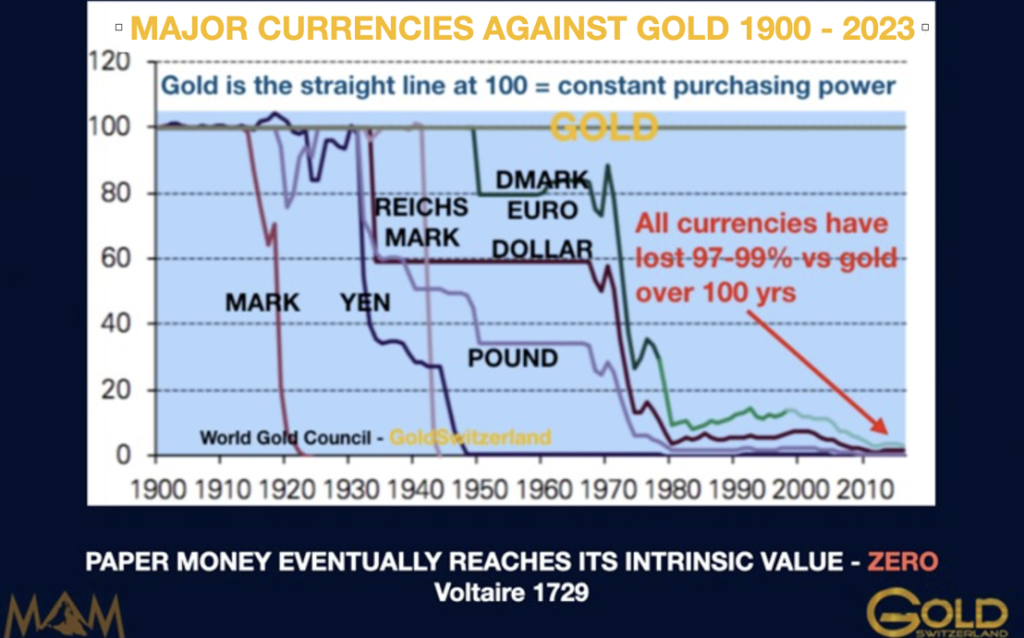
The two principal reasons why the dollar hasn’t yet died is that virtually all other currencies have declined by similar percentages. Also the astute introduction of the Petrodollar in 1973-4, the brainchild of Nixon’s secretary of state Henry Kissinger, played an important role in convincing Saudi Arabia ( the dominant oil producer at the time) to sell oil in dollars against a package of US weapons and protection.
As the West now sinks in a quagmire of debt, corruption and decadence, the world will experience a tectonic shift away from fiat/fake money with zero intrinsic value to currencies backed by commodities with gold playing a central role.
WHERE HAVE ALL THE STATESMEN GONE
The West has not got one single statesman who can pull it out of the swamp. Many countries are now turning to the right like Italy with Meloni and Spain also probably swinging right in July with the Partido Popular and the far right Vox party. Macron is extremely unpopular and Le Pen now leads the opinion polls with 55%. Scholz in Germany has also failed badly and the Nationalist AfD is now ahead of the ruling social democrats in the polls.
The UK is currently the only major country that is likely to turn to the left at the next election in 2025. No one believes in the weak Sunak and Labour leader Kier Starmer is the clear favourite to win. But sadly he is not a statesman either.
So with a motley crew of weak leaders in Europe, things don’t look any better if we look west to the US. Sadly, the US hasn’t got a leader at all. It seems that Biden has got his strings pulled by an unelected and unaccountable team around him. This is an extremely vulnerable situation for what has been the mightiest country in the world. A major military power without a leader is very dangerous.
As President Eisenhower said in the 1950s:

“In the councils of government, we must guard against the acquisition of unwarranted influence, whether sought or unsought, by the military industrial complex. The potential for the disastrous rise of misplaced power exists and will persist. We must never let the weight of this combination endanger our liberties or democratic processes.”
As empires die, weak leaders are the norm and seem a necessary condition to exacerbate the inevitable collapse.
So we can all speculate about the outcome of the current crisis in the West and how it will all end. These situations seldom consist of individual events but are normally processes that take a number of years or even decades.
We must remember that we have already seen half a century of decline since 1971 so we are now likely to experience an acceleration of the process. As I have pointed out above, it is not just the decline of the West which is happening in front of our eyes, but also the emergence of an extremely powerful cooperation of 40 plus countries which will drive a global commodity based expansion on a scale never seen before in history.
Just take Russia. With $85 trillion of natural resource reserves, they will play a major role in this real physical asset expansion as long as the country holds together politically, which I would expect.
Remember that the massive global shift which is about to start is not based on personalities. Leaders are instruments of their time and the right leaders will emerge in most countries to bring about this tectonic shift.
DON’T TOUCH SOVEREIGN DEBT, EVEN WITH A BARGEPOLE
So how will ordinary investors in the West protect and enhance their assets in a world which is on the cusp of major shifts financially, economically and politically?
Well let’s first look at what not to do.
As I have stressed for many years, it is not a matter of maximising returns but minimising risk. After the biggest global asset bubble in history, the everything collapse will be vicious and take down many investments that have been regarded as safe as sovereign debt. See my article “First gradually and then suddenly – the Everything Collapse”.
Take US government bonds or treasuries. For years I have never understood how someone can invest in a “security” which is created by just snapping your fingers. This is how a senior Swedish Riksbank (central bank) official described to a journalist where money comes from. So whether we call it mouse-click money like my good colleague Matt Piepenburg or finger-snapping money, both expressions clearly tell us that we live in a hocus-pocus world where money is unlimited and can be created by snapping your fingers.
Oh yes, we mustn’t forget the additional $2+ quadrillion of quasi debt or liabilities in the form of derivatives. I have argued many times that a big part of these derivatives are likely to become debt as central banks create liquidity to save the financial system from a an implosion of these financial instruments of mass destruction as Warren Buffett calls them.
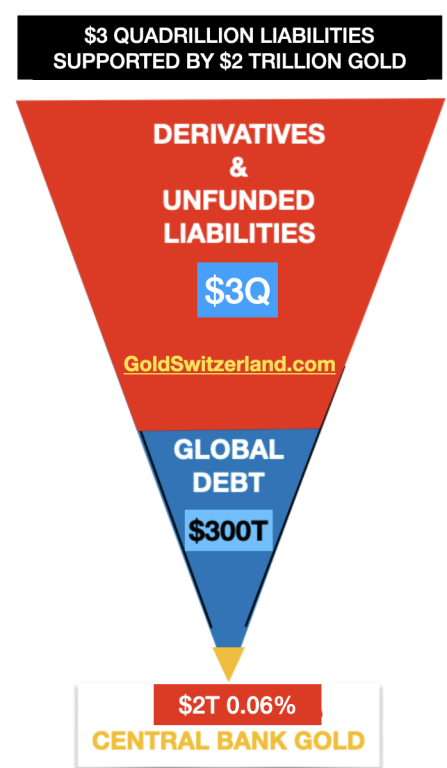
I have long argued that holding Western sovereign debt is financial suicide. Lately some big names agree with me whether it is Jamie Dimon of JP Morgan- “Don’t touch US bonds”- or Ray Dalio the very successful hedge fund investor – “It would take 500 years to get the money back”. Yes, but what money I wonder??
Firstly, whether it is the Fed or the ECB, their balance sheets are insolvent and no one can ever get real money back. At best it would be another worthless debt/money instrument like CBDC (Central Bank Digital Currency) that would lose 99-100% over 1 to 50 years. Not the best of odds to say the least.
The US 10 year treasury bond peaked in 1981 at just below 16% after a 39 year downtrend it bottomed in 2020 at 0.55%. That was the bottom of the interest and inflation cycle. We will now see higher inflation and rates for decades. But it obviously won’t be a move without major corrections and volatility.
As major central banks are pressing for higher rates, one wonders if they are aware of the consequences. Because in a debt infested world, higher rates mean a high risk of default, both private and sovereign.
But in their normal style, central banks will be behind the curve and realise their misdemeanours once the system has collapsed.
NB: The only buyer of US treasuries will be the Fed as the rest of the world runs away from the US poisonous debt chalice. It’s like passing the parcel when you can only pass it to yourself.
OPPORTUNITIES OF A LIFETIME COMING
So buying anything commodity based will be a clear growth area for decades. In this group is not just commodity businesses but companies that supply the commodity companies with software or hardware.
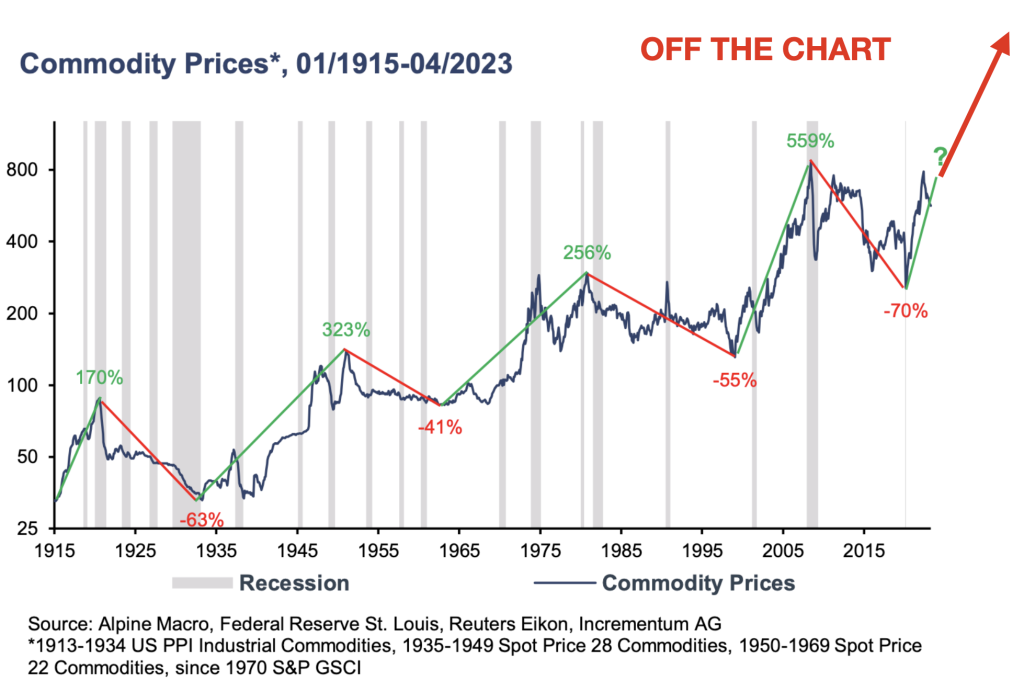
In addition to the precious metals market whether physical or stocks, we see the potentially most interesting areas being oil and uranium.
We have been in the physical precious metals market for almost 25 years for wealth preservation purposes. During that time gold has gone up 6-12 times in most Western currencies and silver slightly less.
As the premier company for bigger wealth preservation investors in physical gold and silver, outside the financial system, we have had a very exciting journey so far.
But looking at the last 23 years I am very clear that in spite of greater returns in physical gold than most investment classes and much lower risk, the real moves haven’t even started yet.
I have never seen a more obvious situation during my soon 60 years in investment markets.
Although some of the precious metals mining stocks will vastly outperform physical gold and silver, we will stick to what we know best in order to serve our esteemed clients as well as future wealth preservation investors.
In coming years, most investors will lose a major part of their investments and net worth as they hold on to their conventional investments.
For a quarter of a century I have been standing on a soap box, imploring investors to protect their wealth. During that time we have seen The Nasdaq lose 80% in the early 2000s and the financial system being a few minutes from implosion in 2008.
But with the help of finger-snapping $10s of trillions into existence, most markets have remained strong. Still, the (almost) Everything Collapse is hanging over us and this time finger-snapping money into existence is unlikely to help.
WHEN SHOULD YOU NOT HOLD GOLD?
You should not hold gold when:
- There are no deficits and there is a balanced budget
- There is negligible or no inflation
- There is no debasement of currencies
- There is strong statesmanship based on real longterm values
When that day comes, we will also see flying elephants as well as flying central bankers with wings!
But just like Icarus, the son of Daedalus in the Greek mythology, these bankers will crash!
Anyone who has held a major part of his wealth in physical gold, in any country, in this century has achieved an excellent return and still has his gold asset intact. He has also been able to sleep well at night.
Although picking the right precious metals stocks can lead to an opportunity of a lifetime, we will still recommend that investors keep the majority of their funds in physical gold and silver, stored in the right jurisdiction and in the safest vaults with direct access to your metals.
That way investors avoid many risks like:
- Custodial risk, your shares held in a fragile financial system
- Political risk, mines are often in risky countries),
- Fraud, corruption, Doug Casey can tell you about this. Read his book Speculator
- Financial risk, many companies will run out of cash
Still I would advise even the cautious investor to hold some gold and silver stocks or a fund or an index, since the upside is substantial.
NO MAJOR GOLD DISCOVERY FOR YEARS
There has not been a major gold discovery for 4 years.
Major gold discoveries over 1 million ounces:
1990s – 180
2000s – 120
2010 to 2018 – 40
2019 to date – 0
Not only do we have peak oil but also peak gold. So the world is facing a vicious a cycle of increasing energy costs leading to higher costs of extracting precious metals and other commodities.
This confirms that high inflation is here to stay, leading to higher interest rates and very high risk of debt defaults within the private and sovereign sectors.
To hold US dollars is to hand your wealth to the state which is likely to either debase it, lose it, spend it, confiscate it or misappropriate it in any other way.
Why would anyone trust a government like the US which currently is doing all of the above things.
And don’t believe that the Euro will fare better.
The only way to be in control of your own money is to hold it in physical gold outside your country of residence in private vaults.
The trust in the US and the dollar is now coming to an end after the confiscation of all Russian assets. Who would want to hold their assets under the control of a government what can just steal it at will.
So we are not facing a dollar crisis. Instead, the dollar and its issuer is the crisis. No one who is worried about preserving his wealth would ever consider holding it in a crisis currency, controlled by a crisis government.
I find it fascinating that the JP Morgan who has become a joint custodian of the GLD gold ETF is planning to move the gold to Switzerland. This confirms my strong view that Switzerland will further strengthen its position as a major gold hub. Currently 70% of all the gold bars in the world are refined in Switzerland which also have more major private gold vaults than any other country.
Also, as I discussed in a recent article, no central bank will want to hold its reserves in US dollars with to a capricious US government that can steal it at will. The only money that could mantle the role as a reserve asset as the dollar fades away is obviously gold.
TOO LATE TO JUMP ON THE GOLD WAGON?
Nobody should believe that it is too late to jump on the Gold Wagon. It has hardly started yet.

Even if the percentage invested in physical precious metals and precious metals stocks, goes from 0.5% to only 1.5%, there will not be enough metals or stocks available to satisfy a fraction of that increase at current prices for the metals.
So the only way that the increased money flows into metals can be satisfied is through vastly higher prices.
AND AS I HAVE OUTLINED IN THIS ARTICLE, THE SCENE IS NO SET FOR SUCH A MAJOR REVALUATION OF GOLD AND SILVER AND THE WHOLE PRECIOUS METALS SECTOR
Jerome Powell: Misunderstood Angel or Open Devil?
We have hardly been the first nor the last to realize that rising rates “break things.”
We’ve all seen the disastrous credit events in the repo crisis of late 2019, the UST debacle in March of 2020, the gilt implosion of October 2022 and, of course, the banking crisis of March, 2023.
And behind, beneath, above and below each of these debacles lies a bemused central banker.
There’s More “Breaking” to Come
But there’s far more “breaking” to come.
As for recessions, the data is equally (and objectively) abundant that those rising rates (red circles below) tend to correlate directly with recessions, both soft and hard (grey lines below).

Powell can re-define recessions with words, but despite his double speak, he too knows that a recession is already under, or at the very least, directly off, the American bow.
Powell’s Un-Spoken “Plan”?
It has always been my contention that the rate hikes of late have been a public ruse to allegedly “defeat inflation,” when in fact inflation and negative real rates were always part of the unofficial plan to help inflate away portions of Uncle Sam’s openly embarrassing bar tab.
More importantly, Powell’s deeper motive (in my opinion) for the rate hikes of 2022 was done in order to give the Fed something to cut once the mammoth recession they’ve publicly denied becomes, well: mathematically undeniable.
The Past as Prologue
As in 2018, when Powell forward-guided rate hikes simultaneously with QT (Fed balance sheet reduction via UST dumping), the end result was disastrous (remember December 2018 and the days of 10% daily market swings).
This disaster was soon followed by an inevitable/foreseeable rate “pause” and then more QE.
The current pattern is fairly similar.
Although a QT policy of letting the Fed’s reserve of bonds “mature” rather than be dumped into the open market slightly differentiates 2022’s rate hikes from 2018, the end-game of raising rates into an even greater debt bubble will end with even more pain, volatility (and ultimately, QE) than seen in the 2018-2019 debacle/policy.
This pattern is easy to see because the Realpolitik of the bond market is easy to see.
The Bond Market is the Thing
In the most simplistic terms, Uncle Sam survives off debt, which means he survives off of IOUs (i.e., USTs).
If no one buys those IOUs, Uncle Sam falls off his bar stool into a puddle of his own tears as USTs fall further in price and hence yields and rates rise further in interest-expense pain.
And as 2022 reminds, that weaponized USD led to Uncle Sam’s worst fears coming foreseeably true as the world dumped USTs at the same time central banks made historically unprecedented purchases of gold.

The Next Moves Are Fairly Easy to See…
Needless to say, this bond-dumping scares the “H-E- double-toothpicks” out of Uncle Sam and his cadre of corporatist, number-crunching technocrats at the Treasury Dept and FOMC, as even they know what we all know: Someone or some thing has to buy Uncle Sam’s IOUs or it’s game over.
And who do you think that buyer will be?
All together now: “The Federal Reserve.”
And where will the money needed to buy those unloved USTs ultimately come from?
All together now: “An inflationary mouse-clicker at the Eccles Building.”
Pain, then Pleasure for Stocks, But No Way Out for the Dollar
But between now and that oh-so-foreseeable QE end-game, more things will need to break, which means we are likely to see deflationary forces (tanking market, emerging recession) followed by profoundly inflationary money printing.
Or stated more simply, stocks will tank and then stocks will rise as the currency which measures (and “saves”) them gets more and more diluted by failed policy makers and a Fed which should never have been conceived in 1910.
Why do I believe this?
Well, the markets, rather than Powell, are telling us so.
Let’s dig in.
The Futures Markets: Neon-Flashing Signs of Stock Market “Uh-Oh”
There are a number of signs pointing toward an “uh-oh” moment in risk assets.
The fact, for example, that we are seeing oil futures pricing oil lower despite production cuts (what the fancy lads call “backwardation”) stems from a market anticipating the kind of tanking oil demand that only comes from a much-anticipated stock market fall (mean reversion) in the wake of an equally anticipated recession in 2023.
The Eurodollar futures market is also screaming of a similar market fall in the coming months.
But perhaps most importantly (or obviously), the S&P futures market is now net-short at levels surpassing 2011 and approaching the levels of late 2007.

If I recall, those were not promising times for subsequent stock prices…
Or stated more simply, the big boys at those oh-so clever hedge funds (who are tracking credit crunches, bond flows and Powell’s “higher-for-longer” meme) are betting heavily against the S&P as the “higher-for-longer” Powell soon becomes the “higher-something-broke-again” Powell.
In short: The next thing to “break” will be stocks.
What Goes Naturally Down Then Goes Un-Naturally Up
Then comes the volatility and the dip-buyers after stocks take a hit (driven by more bank failures and rate hikes) which could be worse than 2008.
It’s my view that hedge funds are waiting to buy low and are biding their time like snipers patiently hiding behind a bond-market breastwork.
That is, they have been piling into negative-yielding USTs of late (that is, willingly losing a bit of return) as a holding pattern “asset” which they will then quickly dump to buy discounted equities once the stock market pukes as per above.
Amidst this looming volatility (buy the VIX?), I thus foresee a subsequent move out of anemic bonds and back into discounted stocks.
Of course, if the hedge funds start dumping Uncle Sam’s IOUs, their yields and rates will get dangerously higher (expensive) for Uncle Sam, which means Uncle Fed will have to do what it did in 2019/2020 and start mouse-clicking more instant liquidity to control Treasury yields and monetize America’s increasingly unloved UST market.
Such QE will be good for stocks dying on the field, but bad for the inherent purchasing power of an ever-more debased and diluted USD.
Chess vs. Checkers
Thus, deflationary or inflationary, the end-game for the neutered USD and its checker-level financial planners is fairly foreseeable, which means the end-game for gold is no less so.
See why the chess-players (mostly Eastern Central Banks) are stacking gold at levels higher than ever recorded?

A Rigged Game
This journey from tanking markets to rising markets is a game which many insiders at the hedge funds know and play well.
Furthermore, it’s a game the Fed has no choice to play, as a rising stock market (and capital gains taxes) is one of the few ways Uncle Sam can get tax receipts at a level high enough to pay its $800B (and climbing) interest expense on debt.
The rise-and-fall stock game is rigged, and ultimately, as I’ve written, “Rigged to Fail,” but regardless of its immoral and capitalism-destroying mandate, one can front-run the Fed if one sees the totally centralized chess-board.
Jerome Powell: Misunderstood Angel or Open Devil?
Below, we look at simple facts in the context of complex markets to underscore the dangerous direction of Fed-Speak and Fed policy.
Keep It Simple, Stupid
It’s true that, “the Devil is in the details.”
Anyone familiar with Wall Street in general, or market math in particular, for example, can wax poetic on acronym jargon, Greek math symbols, sigma moves in bond yields, chart contango or derivative market lingo.
Notwithstanding all those “details,” however, is a more fitting phrase for our times, namely: “Keep it simple, stupid.”
The Simple and the Stupid
The simple facts are clear to almost anyone who wishes to see them.
With US debt, for example, at greater than 120% of its GDP, Uncle Sam has a problem.
That is, he’s broke, and not just debt-ceiling broke, but I mean broke, broke.
It’s just THAT simple.
Consequently, no one wants his IOUs, confirmed by the simple/stupid fact that in 2014, foreign Central Banks stopped buying US Treasuries on net, something not seen in five decades.
In short, the US, and its sacred bonds, just aren’t what they used to be.
To fill this gap, that creature from Jekyll Island otherwise known as the Federal Reserve, which is neither Federal nor a reserve, has to mouse-click money to pay the deficit spending of short-sighted and opportunistic administrations (left and right) year after year after year.
Uncle Fed, along with its TBTF nephews, have thus become the largest marginal financiers of US deficits for the last 8 years.
In short, the Fed and big banks are literally drinking Uncle Sam’s debt-laced Kool aide.
The Fed’s money printer has thus become central to keeping credit markets alive despite the equal fact (paradox) that its rate hikes are simultaneously gutting bonds, banks and small businesses to fight inflation despite the stubborn fact that such inflation is still here.
The Inflation Narrative: Form Over Substance
My view, of course, is that the Fed’s war on inflation is a headline optic rather than policy fact.
Like all debt-soaked and failing regimes, the Fed secretly wants inflation to outpace rates (i.e., it wants “negative real rates”) in order to inflate away some of that aforementioned and embarrassing debt.
But admitting that is akin to political suicide, and the Fed is political, not “independent.”
Thus, the Fed will seek inflation while simultaneously mis/under-reporting CPI inflation by at least 50%. I’ve described this as “having your cake and eating it too.”
All that said, inflation, which was supposed to be transitory, is clearly sticky (as we warned from the beginning), and even its under-reported 6% range has the experts in a tizzy of comical proportions.
Neel Kashkari, for example, is thinking the US may need to get rates to at least 6% to “beat” inflation. James Bullard is asking for more rate hikes too.
But what these “go higher, longer” folks are failing to mention is that rate hikes make Uncle Sam’s bar tab (i.e., debt) even more expensive, a fact which deepens rather than alleviates the US deficit nightmare.
The War on Inflation is a Policy that Actually Adds to Inflation
Ironically, however, few (including Kashkari, Bullard, Powell or just about any economic midget in the House of Representatives) are recognizing the additional paradox that greater deficits only add to (rather than “combat”) the inflation problem, as deficit spending (an economy on debt respirator) keeps artificial demand (and hence) prices rising rather than falling.
Furthermore, these deficits will ultimately be paid for with more fiat fake money created out of thin air at the Eccles building, a policy which is inherently (and by definition): INFLATIONARY.
In short, and as even Warren B. Mosler recently tweeted, “the Fed is chasing its own tail.”
Inflation, in other words, is not only here to stay, the Fed’s “anti-inflationary” rate hike policies are actually making it worse.
Even party-line economists are forecasting higher core inflation this year:

The Real Solution to Inflation? Scorched Earth.
In fact, the only way to truly dis-inflate the inflation problem is to raise rates high enough to destroy the bond market and the economy.
Afterall, major recessions/depressions do “beat” inflation—along with just about everything and everyone else.
The current Fed’s answer to combatting the inflation problem is in many ways the equivalent of combatting a kitchen rodent problem by placing dynamite in the sink.
Meanwhile, the Rate Hikes Keep Blowing Things Up
Buried beneath the headlines of one failing bank (and tax-payer-funded depositor bailout) after the next, is the equally dark picture of US small businesses, all of which rely on loans to stay afloat.
But according to the U.S. Small Business Association, loan rates for the “little guys” have reached double digit levels.
Needless to say, such debt costs don’t just hurt small enterprises, they destroy them.
This credit crunch is only just beginning, as small enterprises borrow less in the face of rising rates.
Real estate, of course, is just another sector for which the “war on inflation” rate hikes are creating collateral damage.
Homeowners enjoying the fixed low rates of days past are naturally remiss to sell current homes only to face the pain of buying a newer one at much higher mortgage rates.
This means the re-sale inventory for older homes is shrinking, which means the market (as well as price) for new construction homes is spiking—serving as yet another and ironic example of how the Fed’s alleged war on inflation is actually adding to price inflation…
In short, Fed rate hikes can make inflation rise, and equally tragic, is that Fed rate cuts can also make inflation rise, as cheaper money only means greater velocity of the same, which, alas, is inflationary…
See the Paradox?
And that, folks, is the paradox, conundrum, corner or trap in which our central planners have placed us and themselves.
As I’ve warned countless times, we must eventually pick our poison: It’s either a depression or an inflation crisis.
Ultimately, Powell’s rate hikes, having already murdered bonds, stocks and banks, will also murder the economy.
Save the System or the Currency?
At that inevitable moment when the financial and social rubble of a national and then global recession is too impossible to ignore, the central planners will have to take a long and hard look at the glowing red buttons on their money printers and decide which is worthing saving: The “system” or the currency?
The answer is simple. They’ll push the red button while swallowing the blue pill.
Ultimately, and not too far off in our horizon, the central planners will “save” the system (bonds and TBTF banks) by mouse-clicking trillions of more USDs.
This simply means that the deflationary recession ahead will be followed by a hyper-inflationary “solution.”
Again, and worth repeating, history confirms in debt crisis after debt crisis, and failed regime after failed regime, that the last bubble to “pop” is always the currency.
A Long History of Stupid
In my ever-growing data base of things Fed-Chairs have said that turned out to be completely and utterly, well…100% WRONG, one of my favorites was Ben Bernanke’s 2010 assertion that QE would be “temporary” and with “no consequence” to the USD.
According to this false idol, QE was safe because the Fed was merely paying out dollars to purchase Treasuries is an even swap of contractually even values.
What Bernanke failed to foresee or consider, however, is that such an elegant “swap” is anything but elegant when the Fed is marred by an operating loss in which its Treasuries are tanking in value.
That is, the “swap” is now a swindle.
As deficits rise, the TBTF banks will require more mouse-clicked (i.e., inflationary) dollars to meet Uncle Sam’s interest expense promise to the banks (“Interest on Excess Reserves”).
In the early days of standard QE operations, at least the Fed’s printed money was “balanced” by its purchased USTs which the TBTF banks then removed from the market and parked “safely” at the Fed.
But today, given the operating losses in play, the Fed’s raw money printing will be like like raw sewage with nowhere to go but straight into the economy with an inflationary odor.
Bad Options, Fluffy Words
Again, the cornered Fed’s options are simple/stupid: It can continue to hawkishly raise rates higher for longer and send the economy into a depression and the markets into a spiral while declaring victory over inflation, or it can print trillions more fiat dollars to prop the system and neuter/debase the dollar.
And for this wonderful set of options, Bernanke won a Nobel Prize?
The ironies do abound…
But as a famous French moralist once said, the highest offices are rarely, if ever, held by the highest minds.
Gold, of course, is not something the Fed (nor anyone else) can print or mouse-click, and gold’s ultimate role as a currency-insurer is not a matter of debate, but a matter of cycles, history and simple/stupid common sense. (See below).
Markets Are Prepping
In the interim, the markets are slowly catching on to the fact that protecting purchasing power is now more of a priority than looking for safety in grossly and un-naturally inflated “fixed income” or “risk-free-return” bonds.
Why?
Because those bonds are now (thanks to Uncle Fed) empirically and mathematically nothing more than “no-income” and “return-free-risk.”
Meanwhile, hedge funds are building their net short positions in S&P futures at levels not seen since 2007 for the simple reason that they foresee a Powell-induced market implosion off the American bow.
Once that foreseeable implosion occurs, get ready for the Fed’s only pathetic tools left: Lower rates and trillions of instant liquidity—the kind that kills a currency.
In Gold We Trust
The case for gold as insurance against such a backdrop of debt, financial fragility and openly dying currencies is, well: Simple stupid and plain to see.
Few on this round earth see the simple among the complex better than our advisor and friend, Ronni Stoeferle, whose most recent In Gold We Trust Report has just been released.
Co-produced with his Incrementum AG colleague, Mark Valek, this annual report has become the seminal report in the precious metal space.
The 2023 edition is replete with not only the most sobering and clear data points and contextual common sense, but also a litany of entertaining quotations from Churchill and the Austrian School to The Grateful Dead and Anchorman …
Ronni and Mark unpack the consequences of a Fed that has raised rates too high, too fast and too late, which is, again a fact plain to see:

Needless to say, hiking rates into an economic setting already historically “debt fragile” tends to break things (from USTs to regional banks) and portends far more pain ahead, as both history and math also plainly confirm:

In a debt-soaked world fully addicted to years of instant liquidity from a central bank near you, Powell’s sudden (but again too late, too much) hiking policies will not “softly” restrain market exuberance nor contain inflation without unleashing the mother of all recessions.
Instead, the subsequent and sudden negative growth of money supply will only hasten a recession as opposed to a “softish” landing:

As the foregoing report warns, the looming approach of this recession is already (and further) confirmed by such basic indicators as the Conference Board of Leading Indicators, an inverted yield curve and the alarming spread between 10Y and 2Y yields.
Self-Inflicted Geopolitical Risks
The report further examines the geopolitical shifts of which we have been warning(and writing) since March of 2022, when Western sanctions against Russia unleashed a watershed trend by the BRICS and other nations to seek settlement payments outside of the weaponized USD.
One would be unwise to ignore the significance of this shift or underestimate the growing power of these BRICS (and BRICS “plus”) alliances, as their combined share of global GDP is rising not falling…

As interest in (and trust for) the now weaponized USD as a payment system declines alongside a weakening faith in Uncle Sam’s IOUs, the world, and its central banks (especially out East) are turning away from USTs and turning toward physical gold.
Again, I give credit to the In Gold We Trust Report:

See a trend?
See why?
It’s fairly simple, and for this we can thank the fairly stupid policies of the Fed in particular and the declining faith in their prowess in general:

Myths Are Stubborn Things
Many, of course, find it hard to imagine that a Federal Reserve based in DC and within the land of the Great American dream (and world reserve currency) could be anything but wise, efficient and stabilizing, despite an embarrassing Fed track record that is empirically unwise, inefficient and consistently destabilizing…
Myths are hard to break, despite the fact the myth of MMT and QE on demand has been a failed experiment and is sending the US, as well as the global, economy toward a reckoning of historical proportions.
But the messaging of “Keep calm and carry on” from Powell is calming in spirit despite the fact that it hides terrifying math and historically confirmed consequences for the fiat money by which investors still wrongly measure their wealth.
But as Brian Fantana of Anchorman would tell us, trust the central planners.
“They’ve done studies, you know. 60% of the time it works every time.”

As for us, we trust the kind of data Ronni and Mark have gathered and that barbarous relic of gold far more than calming words and debased, fiat currencies.
As history reminds, when currencies die within a backdrop of unsustainable debt, gold in fact does work—and every time.
Jerome Powell: Misunderstood Angel or Open Devil?
Below, we see why the USA is screwed.
De-Dollarization: Downplaying the Obvious
De-Dollarization is a real, all too real trend, though it is both fascinating and disturbing to see what is otherwise so obvious being deliberately down-played, excused or ignored from the top down.
But then again, the laundry list of ignored facts and open lies from the top down to hide hard truths in everything from inflation data to recessionary debt traps is nothing new.
Instead, such propaganda replacing blunt transparency is the new normal (and classic trick) for all historical endings to debt-soaked (and failing) nations/systems and their fork-tongued (i.e., guilty) policy makers.
Slow & Steady
De-Dollarization, of course, is a gradual rather than over-night process.
Its origins stem from 1) years of exporting USD inflation overseas (to the painful detriment of friend and foe alike) and 2) the insanely stupid decision to weaponize the world reserve currency (i.e., USD) subsequent to a border war between two local tyrants in the Ukraine.
Whether or not you buy into the Western “media’s” narrative which categorizes Putin as Hitler 2.0 and Zelensky as a modern George Washington, the weaponization of the USD (and freezing of FX reserves) has made an already dollar-tired globe even more distrusting of Uncle Sam’s currency and IOUs.
This trend is confirmed by the profound dumping of USTs throughout 2022 and the undeniable trend among the BRICS (and the 36 other nations) to deliberately seek bilateral trade agreements and settlements outside of the USD.
Furthermore, with Saudi talking to China and Iran, and with China talking to Mexico, Russia and just about everyone else, it’s fairly clear that a move away from the once sacred petrodollar (Pakistan now seeking Russian oil in Yuan) is no longer just the fantasy of conveniently eliminated folks like Saddam Hussein or Muammar Gaddafi…
As I discussed here and here, the petrodollar is under threat, which means longer-term demand for the USD is equally so.
But the USD Still Has Legs—For Now…
That said, there’s also no denying that the USD is still very strong, very important and very much in demand.
After all, and despite welching in 1971 on its 1944 promise to be gold-backed, the USD is still the world reserve currency.
With over 40% of global debt instruments denominated in Greenbacks and over 60% of the reservoir of global currencies composed of USDs, this reserve status (and hence forced demand) aint going anywhere too soon.
Furthermore, and as I have written and agreed, the so-called “milk-shake theory” is not altogether wrong.
That is, demand for USDs (and USTs) within the tangled and levered web of US derivative and Euro Dollar markets is baked into a system which will take years (not days) to unravel, monetize or replace, and this sure as heck won’t be orderly, global nor overnight.
Then Comes Change, Pain and Open Denial
But let’s get real: The days of the USD as a trusted payment system or hegemonic power broker are unwinding right before our very eyes.
And the best way to see the truth of this reality is to catalogue the ever-expanding list of lies from the big boys and their complicit, media ja-sagenders (“yes-sayers”) desperately trying to deny the same.
At first, for example, the centralized economists were blaming de-dollarization and CNY energy transactions on the Russian sanctions.
Gee. Go figure?
Thereafter, the economists said de-dollarization is just the result of Emerging Market (EM) countries momentarily running out of (in fact they’re intentionally dumping) USD reserves.
Western “experts” are trying to convince themselves and the rest of the world that EM nations will implode unless they eventually acquire more USTs and USDs to buy energy.
What these experts are failing to see (or say), however, is that many of those countries are already beginning to buy that energy outside of the USD…
Folks, de-dollarization in global commodity markets is happening already, and will accelerate rather than fade away into some fantasy image of how the “West was Won,” for as argued elsewhere, the West is already losing.
Facts Are Stubborn Things
As for the list of nations, both big and small, de-dollarizing right before our watering eyes, just consider, well…China, Russia, India, Pakistan, Ghana, Bolivia…
Even the world’s largest hardwood pulp producer, Suzano SA, is in talks with China to trade its commodity in CNY.
This transition from a weaponized USD to an expanding CNY is not just the sensationalism of fiat-haters but the hard math of real events and data, which the following chart of the Renminbi Globalization Index (up 26% in 2022) makes all too clear…

The undeniable trend and rise (which is not the same as “hegemony”) of the CNY is certainly not good news for the fiat-all-too-fiat USD, who is less and less the prettiest girl at the dance.
As trust/demand in the USD falls, so too does its purchasing power, which may explain why China, at the very same time its trade power increases, is simultaneously growing its gold reserves in anticipation for what it knows is coming but what the West still refuses to see, namely: The slow-drip neutering of Uncle Sam’s fiat currency.
See the trend folks?
We Told You So
See why picking a currency-for-energy war against Russia (the world’s biggest commodity exporter and a nuclear power in bed with China, the world’s biggest factory owner and a nuclear power) may have been a bad idea?
As we warned literally from day-1 of the sanctions, this was obviously not the same as picking a sanction fight with say, Iran or Venezuela…
Nope. This scale of this was far more dangerous, and the avoidable casualties still piling up in the West’s proxy war (on Ukrainian soil/rubble) are not just soldiers and civilians, but Greenbacks too.
This was foreseeable.
Even Obama foresaw it in 2015:

Clearly, Biden’s handlers, however, didn’t see it in 2022.

They wanted to play war rather than sound economics, and the end result will be a loss of both.
As for the USD: Volatility Before Debasement
As for the fate and price of the USD near-term and long-term, the move will be volatile rather than in a straight line north or south.
The USD can still go higher, much higher, as fewer Greenbacks overseas still face large debt payments.
Ultimately, however, Uncle Sam’s own twin deficits and schoolyard of children masquerading as House Members/”leaders” will deficit spend the USA into a debt spiral whose only “cure” is more mouse-clicked and debased dollars along side more unloved and over-issued USTs (IOUs).
Thereafter, the up and down moves of the USD will eventually just sink, Titanic-like, in one direction as ever-more USD’s collide with a growing debt iceberg.
As argued so many times, but worth repeating: The last bubble to die in a debt-soaked regime is always the currency. Even the increasingly unloved world reserve currency will be no exception to the laws of over-supply and decreasing demand.
Between now and then, all we can expect are more lies from on high and more centralized controls masquerading as efficient payment systems and national emergencies blamed on Eastern bad guys and bat-made (?) virusesrather than the bathroom mirrors of our central planners (happy idiots?).
All Good Until Things Break
We have always warned that Powell’s rate hikes (too much, too fast, too late) would be too expensive for Uncle Sam, and would thus break things here and abroad—from repo markets, gilt markets and Treasury markets to a US fiscal implosion and dying regional banks.
Next to implode are the labor markets.
Six decades of data confirm that rising rates always break things.
But when you place such rising rates into the context of the greatest debt crisis in US (as well as global) history, the “breaking” gets really ugly.
Until the Fed supplies more inflationary liquidity (fiat-fantasy money), the dual forces of a hawkish Powell and a de-dollarizing yet milk-shake world means the USD could rise and squeeze out the dollar short traders nearer term.
Anything but “Softish”
Ultimately, however, and after enough smaller banks have been murdered (more will die) and after the UST market has suffered all it can suffer, too much will break at once, and it won’t be soft, or even “softish.”
This is not fable but fact. The only “tool” the centralizers will have left is more synthetic, fiat (and inflationary) liquidity on demand.
This trend is simple: Uncle Sam is broke and his only solution is a money printer.
In short, a counterfeit answer to a real cancer.
Don’t believe me?
Just ask the US Treasury Dept.
More Ignored Math from DC
The latest TBAC (Treasury Borrowing Advisory Committee) confirms the US has already deficit spent $2.060T in fiscal 1H23, the interest expense alone of which is 101% of tax receipts.
This effectively puts the USA into a red-zone of imbalance reminiscent of the COVID crisis, only this time they don’t have COVID to blame for a debt addiction that was in play long before Fauci stained our screens or Powell printed more money post-March-of-2020 than was produced in the entire compounded history of our nation.
The TBAC report further indicated that projected US Federal deficits for 2023 to 2025 have risen by 30-50% in just the last 90 days…
And folks, the only way to pay for this embarrassing bar tab in DC is either more open QE (mouse-clicked trillions) and/or a much, much, much weaker USD to inflate away this debt as we head simultaneously into the mother of all recessions.
Such a crisis, of course, could be preceded by temporary (relative, rather than inherent) spikes in the USD until more UST supply/liquidity weakens the Greenback and sends gold higher, regardless of the USD’s relative strength and then subsequent weakness.
Meanwhile the Propaganda from On-High Continues
As I’ve said in interview after interview, you know things are getting really bad when comforting words and de-contextualized data increasingly replace simple (but scary) math.
At $95+T in public, household and corporate debt, the US has irreversibly passed the Rubicon of any easy solutions.
As Egon von Greyerz makes abundantly clear week after week, the US in general and the Fed in particular have irrevocably cornered themselves.
Stated otherwise: The USA is screwed.
DC has to chose between saving its “system” (of insider/TBTF banks, self-interested politicos–from the Maoist “woke” to the neocon “dark” and Wall Street Socialism) or destroying its currency.
Needless to say, it’s ultimately the currency that will fall on the sword for this now openly corrupt and pathetic “system.”
But again, rather than confess their own sins, the message is always “be calm and carry on.”
The Latest Fantasy Chart
Take, for example, the latest puff-tweet regarding Bloomberg’s “US Economic Surprise Index” which paints an oh-so rosy picture of the US economy rising at the fastest pace in over a year.

But as far smarter folks than me (i.e., Luke Gromen) will remind, this so-called data is ignoring a few contextual elephants in the room…
Context Helps
First, the above “good news” ignores a US debt/GDP ratio of 125%, a deficits/GDP ratio of 8% and government spending at 25% of GDP.
Secondly, US Government Outlays (i.e., deficit spending) has been growing at 30% for five of the last seven months.
Spending rates like this have only occurred twice in the last four decades, namely: 1) during the height of the COVID hysteria and 2) during the height of the 2008 GFC.
So, despite the “good news” in puff-charts above, the pundits are ignoring the fact that Uncle Sam (and his mis-fit children in the House of [lobbied] “Representatives”) are spending as if the USA is already in the eye of a financial storm.
And yet we haven’t even seen the recession officially hit or labor and risk markets tank, YET.
Imagine the spending when things get officially far worse than today—and they will; it’s now mathematical.
Out of Sight, Out of (Our) Mind
Sadly, however, very few investors are seeing the bigger picture and the wandering elephants.
In the interim: 1) the military industrial complex will create more profits and jobs here and more casualties overseas; and 2) deficit spending will keep unemployment in check (for now) and GDP “stable” until 3) its deficits (and debts) cancerously metastasize within a nation frog-boiling in debt and fractured by manufactured identity politics over transgender beer ads and slavery reparations from the 1860’s.
Such “woke” trends are ironic, given the fact that middleclass Americans of all colors, sexualities, “privileges” or political bends are already unknowing slaves/serfs in a modern feudalism of fake capitalism fighting against the bogus (yet SJW) “equity” euphemism of a woke (but hidden) re-distribution of social “shares” smacking of modern yet genuine Marxism.
Slowly, Then All at Once
And amidst all this distraction, division and in-fighting, the reality of rising rates colliding into historically unprecedented debt levels will just crush all stripes of Americans in the same manner Hemingway described poverty: “Slowly, then all at once.”
As Egon has often told me: Be careful what you wish for or already know.
Gold will inevitably go higher as the rest of the nation/world slides into its foreseeable debt trap and fiat end-game.
This may be obviously good for gold; but it will be at the expense of so much else, as the disorder ahead is neither fun nor pretty.
And it’s only just beginning…
Jerome Powell: Misunderstood Angel or Open Devil?
Tectonic shifts lie ahead. These will involve a US and European debt crisis ending in a debt collapse, a precipitous fall of the dollar and the Euro with Gold emerging as a reserve asset but at multiples of the current price.
The next phase of the fall of the West is here and will soon accelerate. It has been both precipitated and aggravated by the absurd sanctions of Russia. These sanctions are hurting Europe badly and affecting the US in a way that they didn’t expect, but was obvious to some of us. The Romans understood that free trade was essential between all the countries that they conquered. But the US administration blocks have both the money and the ability to trade of the countries they don’t like.
But shooting yourself in the foot really hurts and the consequences are in front of our eyes. No foreign country will want to hold US debt or dollars. That is a catastrophic problem for the US as their deficits will grow exponentially in coming years.
So a debt collapse is not just a looming disaster but a bomb hurling towards the US economy at supersonic speed.
With the imminent death of the petrodollar and explosion of US debt, there is only one solution for the funding requirements of the US Government – the FED which will stand as the sole buyer of US Treasuries.
A CATASTROPHIC DEATH SPIRAL
So the DEBT spiral of higher debt, higher deficits, more Treasuries, higher rates and falling bond prices will soon turn into a DEATH spiral with a collapsing dollar, high inflation and most probably hyperinflation. Sounds like default to me but that word will probably never be used officially. It is hard to admit defeat even when it stares you in the face!

Yes, the US will probably obfuscate the situation with CBDCs (Central Bank Digital Currencies) but since that is just another form of Fiat money, it will at best buy a little time but the end result will be the same.
US Debt Ceiling Farce belongs to Broadway rather than Wall Street

The debt ceiling was created in 1917 as a means of restricting reckless spending by the US government. But this travesty has gone on for over 106 years. During that time there has been a total disdain for budget discipline by the ruling Administration and congress.
The problem is not just the debt but the cost of financing it.
The annualised cost of financing the Federal debt is currently $1.1 trillion. If we assume conservatively that the debt grows to $40 trillion within 2 years, the interest cost at 5% would be $2 trillion. That would be 43% of current tax revenue. But as the economy deteriorates, interest will easily exceed 50% of tax revenue. And that is at 5% which will probably be much too low as inflation rises and The Fed loses control of rates.
Thus a very dire scenario lies ahead and that is certainly not a worst case scenario.

THE FED IS BETWEEN A ROCK AND A HARD PLACE

The Fed and the thus US government are now between Scylla and Charybdis (Rock and a Hard Place).
As it looks today, the US will bounce between Scylla and Charybdis in coming years until the US financial system and also the economy takes ever harder knocks and goes under just as every monetary system has in history.
Obviously the rest of the West including an extremely weak Europe will follow the US down.
BRICS AND SCO – RISING POWERS
The whole world will suffer but the commodity rich nations as well as the less indebted ones will ride the coming storm far better.
This includes much of South America, Middle East, Russia and Asia. The expanding power blocks of BRICS and SCO (Shanghai Cooperation Organisation) will be the strong powers where a much increasing part of global trade will take place.
Barring major political and geopolitical upheavals, China will be the dominant nation and the main factory of the world. Russia is also likely to be a major economic power. With $85 trillion of natural resource reserves, the potential is clearly there for this to happen. But first the political system of Russia needs to be “modernised” or restructured.
What I outline above is of course structural shifts that will take time, probably decades. But whether we like it or not, the first phase, which is the fall of the West, could happen faster than we like.
A MONETARY SYSTEM ALWAYS ENDS IN A DEBT EXPLOSION
In 1913, total US debt was negligible, and in 1950, it had grown to $406 billion. By the time Nixon closed the gold window in 1971, debt was $1.7 trillion. Thereafter the curve has become ever steeper as the graph below shows. From September 2019 when the US banking system started to crack, the Repo crisis told us that there were real problems although no one wanted to admit it. Conveniently for the US government, the Repo crisis became the Covid crisis which was a much better excuse for the Government to print unlimited amounts of money together with the banks.
Thus, just in this century, total US debt has grown from $27 trillion to $94 trillion!

But that was history and we know we can’t do anything about the past. But now comes the fun.
I have been warning about a coming debt explosion for some time. Well, I believe this is it.
In a recent article about the price of gold I explained that the final stages of hyperinflation are exponential.

We will see a very similar exponential pattern with the coming debt explosion. If we assume that the final 5 minutes of the exponential phase started in September 2019, the stadium was then only 7% full and will in the next few years grow from 7% to 100% full or 14X from here.
This is obviously just a demonstration and no exact science, but it shows that theoretically US debt could now explode.
So let’s take a quick look at a few factors that will cause the debt explosion.
BANK FAILURES
A Hoover Institute report calculates that more than 2,315 US banks currently have assets worth less than their liabilities. The market value of their loan portfolios are $2 trillion lower than the book value. And remember this is before the REAL fall of the asset values which is still to come.

Just take US property values which are greatly overvalued by the lenders:

So the four US banks that have gone under recently are clearly just the beginning. And no one must believe that it is just small banks. Bigger banks will follow the same route.
During the 2006-9 subprime crisis, bailouts were the norm. But at the time, it was said that the next crisis would involve bail-ins.
But as we have seen so far in the US, there were no bail-ins. Clearly the government and the Fed were concerned about a systemic crisis and did not have the guts to bail in the bank customers, not even above the FDIC limit.
As the crisis spreads, I doubt that bank depositors will be treated so leniently. Neither the FDIC, nor the government can afford to rescue everyone. Instead depositors will be given an offer they can’t refuse which is compulsory purchase of US treasuries equal to their credit balance.
The European banking sector is in an even worse state than the US one. European banks are sitting on large losses from bond portfolios acquired when interest rates were negative. No one knows at this stage the magnitude of the losses which are likely to be substantial.
Both in commercial property and housing, the situation is worse in Europe than in the US since the European banks are funding most of these loans directly themselves, including € 4 trillion of home mortgages.
The banks also have a mismatch between low rates received on mortgages against high rates paid to finance them.
The ex-governor of the Bank of France and ex-head of the IMF, Jacques de Larosière accuses the authorities of subverting the private banking system with deranged volumes of QE after it had become toxic:
“Central banks, far from promoting stability, have delivered a Masterclass in how to organise financial crisis”
$3 QUADRILLION OF GLOBAL DEBT & LIABILITIES
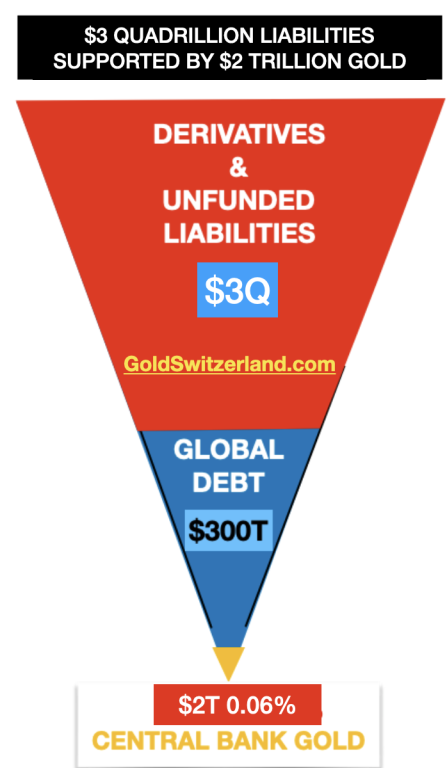
If we add the unfunded liabilities and the total outstanding derivatives to the global debt, we arrive at around $3 quadrillion as I discussed in this article:
“This is it! The financial system is terminally broken”
Sadly, the Western financial system is now both too big to save and too big to fail.
Still all the king’s horses and all the king’s men cannot save it. So even if the system is too big to fail, it will with very dire consequences.
GOLD TO BE SUBSTANTIALLY REVALUED IN THE DISORDERLY RESET
Just over a century after the creation of the Fed and the beginning of the debt ceiling, the mighty dollar has lost 99% of its value in purchasing power terms.
And measured against the only money which has survived in history – Gold – the dollar has also lost 99%.
This is obviously not an accident. Not only is gold the only money which has survived but also the only money which has kept its purchasing power throughout the millennia.
For example, a Roman Toga cost 1 ounce of gold 2000 years ago, which today is also the price for a high quality man’s suit.
You would have thought that losing 99% of its value for the reserve currency of the world would be a disaster. Well it is of course, but the US, as well as most of the Western world, has adjusted by increasing debt exponentially to make up for the disastrous debasement of the currencies.
What is even more interesting, gold is up 8-10X this century against most currencies.
That is a superior performance to virtually all major asset classes.
And still nobody owns gold which is only 0.5% of global financial assets.
More recently gold is at all-time-highs in all currencies including the dollar.
But in spite of the extremely strong performance of gold or more correctly put, the continued debasement of all currencies, no one talks about gold.
Just looking at the number of articles covering gold in the press in the graph below (white bars), it confirms that the most recent price increase of gold (blue line) is met by a yawn.
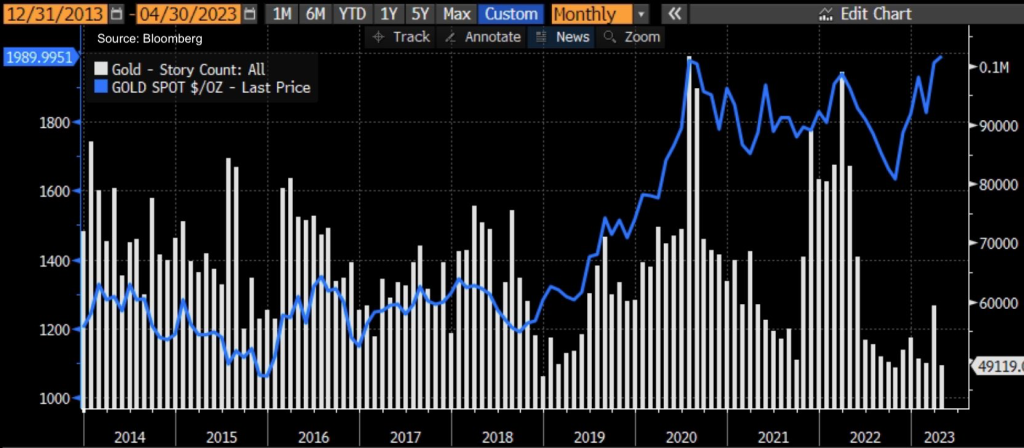
This is obviously very bullish. Imagine if all stock markets made new highs. It would be all over the media.
So what this is telling us is that this gold bull market, or currency bear market, has a very long way to go.
As I often point out, no fiat money but only gold has survived throughout history.
Gold’s rise over time is always guaranteed as governments and central banks will without fail destroy their currency by creating virtually unlimited fake money.
Since this has been going on for 1000s of years, history tells us that this trend of constantly debasing fiat money is unbreakable due to the greed and mismanagement of governments.
And now with the debt crisis accelerating, so will the gold price.
Luke Groman makes a very interesting point in his discussion with Grant Williams (grant-williams.com by subscription). Luke suggests that although the dollar will not yet die as a transactional currency, that it is likely to be replaced by gold as the reserve asset currency.
The combination of dedollarisation and liquidation of US treasuries by foreign holders will lead to this development.
Commodity countries will sell for example oil to China, receive yuan and change the yuan to gold on the Shanghai gold Exchange. They will then hold gold instead of dollars. This will avoid the dollar as a trading currency when it comes to commodities.
In order for gold to function as a reserve asset, it will need to be revalued with a zero at the end and a bigger figure at the beginning as Luke says. The whole idea would be that gold will become a neutral reserve asset which floats in all currencies.
The inverse triangle of Global debt resting on only $2 trillion of Central Bank gold shown above makes the revaluation of gold obvious.
A floating gold price as a reserve asset is of course much more sensible than a fixed gold price backing the currencies and would be the nearest to Free Gold.
See my 2018 article, “Free Gold will kill the Paper Gold Casino”.
So the consequence of gold becoming a reserve asset could involve a rise of say 25X or 50X the current level. Certainly not an improbable outcome in today’s money. The debasement of the dollar and other Western currencies is likely to have a similar effect but then we are not talking in today’s money. Time will tell.
As gold is now in an acceleration phase, we are likely to see much higher levels however long it takes and whatever the reason is for the rise.
The 1980 gold price of $850, adjusted for real inflation would today be $28,300

As gold is now in an acceleration phase, we are likely to see much higher levels however long it takes.
What is clear is that fiat money, bonds, property and stocks will all decline precipitously against gold.
What is important for investors is to take protection now against the most significant RESET in history which is a disorderly reset.
So if you don’t hold gold yet, please, please protect your family, and your wealth by acquiring physical gold.
Gold repositioning as a Global Reserve Asset could happen gradually or it could happen suddenly. But please be prepared because when it happens you don’t want to hold worthless paper money or assets.
Jerome Powell: Misunderstood Angel or Open Devil?
Below we look at the math, history and current oil environment in the backdrop of a global debt crisis to better predict currency and gold market direction without the need of tarot cards.
Seeing the Future: Math vs. Crystal Balls
Those looking forward only need to look at current and backward math to make relatively clear forecasts without risking the mug’s game of deriving crystal ball predictions.
Not surprisingly, the theme and math of simple (as well as appalling) US debt levels makes such forward-thinking almost too simple.
The Oil Issue: Is Anti-Shale Anti-American?
Although not as fluent as others in the oil trade or the green politics of the extreme US left, I’ve argued in prior reports that the current administration’s anti-shale policies make for some good (debatable?) environmental chest-puffing while ignoring the math, history and science of sound national as well as well as global thinking.
(But then again, the entire woke fiasco of current US policy seems to be on a crusade to cancel such things as math, history and science; so, thinking contextually or globally is beyond their sound-bite-driven stump-speeches.)
Oil, however, still matters.
And when understood in the broader context of the macro-economic themes we’ve tracked for years–namely debt, currencies, inflation, gold, a cornered Fed and a weaponized USD–the current and future trends are already in motion.
And as for the endless debate as to global warming, butterfly-friendly energy policies and the simple reality of fossil fuels as a part of, rather than threat to, our planet, I’m certainly not here to answer or solve the same.
Certainly the Germans (and their solar powered ideas in a part of Europe with very little sun) are not getting it… In fact, they are getting much of their (nuclear) energy from France and are now forced to burn coal to get through the winter.
I am here, however, to lay down some objective facts and ask some blunt questions.
Oil Politics
Biden, it seems fairly clear to all, is not in charge of US policy.
That’s a scary fact. Even more scary, however, is determining who is in charge?
Again, not something I can answer.
But if he were in charge, we’d all be amused to ask how he expected Saudi Arabia to welcome him and his embarrassing pleas for Saudi production increases (to ostensibly ease inflated US fuel costs) after previously telling the world he considered Saudi Arabia a pariah state…
We all remember that embarrassing fist-pump with the Crown Prince.

Meanwhile, Saudi is now spending far more time with the Chinese and Iran…
We’d also love to hear the White House explain how it expects increased US shale production to reduce energy inflation when it has been simultaneously seeking to legislate oil off the American page.
Furthermore, it would be worth reminding Americans and politicians tired of inflated fuel prices that the vast majority of those inflated pump costs are due to US taxes per gallon, not Saudi production cuts.
But I digress.
Oil Math
At the current levels of US oil production and exploration, the US (according to its own Dallas Fed) will have to engage in annual energy price inflation levels of 8-10% just to keep the oil industry’s lights on at a breakeven price level.
Such conservative inflation figures for oil/fuel pricing, when seen in the context of over $31T in US Federal debt, basically means that Uncle Sam’s ability to cover his ever-increasing public debt burden will weaken by at least 8-10% per year at a moment in US history where Uncle Sam needs all the help, rather than weakness, he can get.
Fighting Inflation with Inflation, and Debt with Debt?
Needless to say, the only “solution” to these inflated debt burdens will be the monetary mouse-clicker at the Eccles Building, whose doom-loop (yet now ossified) “solution” to addressing inflated oil prices is the even more inflationary policy of printing more fake money to “fakely” cure an inflation crisis.
You really can’t make this stuff up.
Fed monetary policy, ever since patient-zero Greenspan sold his soul (and sound-money, gold-backed academic thesis) to Wall Street and Washington, boils down to this: We can solve a debt crisis with more debt, and an inflation crisis with more, well…inflation.
Does this seem like “sound monetary policy” to you?
Or, Just Export Your Inflation to the Rest of the World?
But as I’ve warned for years, Uncle Sam’s first instinct (as holder of the world reserve currency) whenever handed a hot-potato of self-inflicted inflation, is to hand it off to the rest of the world—i.e., to export his inflation to friends and foes alike.
Global energy importers in Europe, emerging markets, India, China, and Japan, for example, are facing what accountants call a balance of payments crisis, but what I’ll bluntly call by its real name: A currency crisis.
That is, under the current, but potentially dying petrodollar system, these countries will need more USDs to buy oil.
But that’s where the problem lies.
Why?
Simple: Those USDs are drying up (unless more are printed).
How Long Will Global Currencies (& Leaders) Remain Prisoner to the USD?
Regardless of whether you believe in the perpetual hegemony of the USD as a payment system or not, we can all agree that USD liquidity is drying up (whether it be from the milk-shake theory absorption in euro-dollar and derivative markets or from post-sanction de-dollarization).
Nations facing the double whammy of needing more USDs to pay for inflated oil prices and inflated USD-denominated debts around the globe are going to being crying “uncle!” rather than just “Uncle Sam.”
What can these nations do in the face of that bullying hot potato known as the USD? How can they service these increased USD payment (oil and debt) burdens?
How the US Creates a Global Currency Crisis
Well, short of turning their backs on the USD (not yet), the only current option other nations have is to devalue (i.e., inflate and debase) their own currencies at home, which is how Uncle Sam makes his problem just about everybody else’s problem…
As I often say, with friends like the US, who needs enemies?
Something, however, has to give.
How Physical Gold Offers Better Pricing than Fiat Dollars
This clearly broken system of the US exporting its inflation upon a world forced since the 1970’s to import oil under a broken and inflationary Greenback has a genuine potential to implode.
Already, countries like Ghana have realized that it’s better to trade oil in real gold rather than fake fiat dollars.
Long before the petrodollar became the mad king, for example, history recognized that physical gold was a far better instrument of payment to settle stable oil pricing.
See for yourself.

As more and more of the world recognizes the currency crisis slowly in play now, and then steadily in greater pain tomorrow, this “Balance of Payments” (i.e., currency) crisis can easily evolve into a “change of payments” reality in which gold re-emerges as a superior payment system for oil.
Think about that.
More Tailwinds for Gold
As of this writing, the physical oil markets are greater than 15X the size of the physical gold markets on an annualized (USD) production basis.
If the world turns slowly (then all at once?) toward settling oil in gold (partially or fully) to avoid a global currency crisis, gold will have to be repriced at levels significantly higher than current pricing.
Hmmm.
Something worth tracking, no?
Well, the Zeitgeist suggests that we are not the only ones tracking these trends…
The Central Banks Are Catching On to (and Stacking) Gold
A recent pole of over 80 central banks holding greater than $7T in FX reserves indicated that 2 out of 3 polled strongly believe that central banks will be making more, not less, purchases of physical gold in 2023.
Again: Are you seeing a trend? Are you seeing the context? Are you seeing why?
As I’ve said countless times and will say countless times more: Debt matters.
Debt matters because debt, once it crosses the Rubicon of insanity and unsustainability, impacts everything we market jocks were supposed to have been taught in school and in the office—namely bonds, currencies, inflation and recessionary cycles follow debt cycles.
In short: It’s all tied together.
Once you understand debt, the policies, reactions, weaknesses, truths, lies, and cycles are far easier to see rather than just “predict.”
The increasing loss of faith in the world reserve currency and its embarrassing IOUs (i.e., USTs) is not merely the domain of “gold bugs” but the simple and historical consequence of the blunt math which always follows broken regimes, of which the US is and will be no exception.
The graph below, is thus worth repeating, as the world is clearly turning away from Uncle Sam’s drunken bar tabof debased dollars and IOUs toward something more finite in supply yet more infinite in duration.

Again: See the trend?
Jerome Powell: Misunderstood Angel or Open Devil?
From oil markets to treasury stacking, backdoor QE, investor fantasy and hedge fund prepping, it’s becoming more and more clear that the big boys are bracing for disaster as gold stretches its legs for a rapid run north.
Recently, I dove into the cracks in the petrodollar as yet another symptom of a world turning its back on USTs and USDs.
Gold, of course, has a role in these headlines if one looks deep enough.
So, let’s look deeper.
Diving Deeper into the Oil Story
The headlines of late, for example, are all about “surprise” OPEC production cuts.
Why is this happening and what does it say about gold down the road?
First, let’s face the politics.
As noted many times, it seems US policy, on everything from short-sighted (suicidal?) sanctions to the “green initiative” makes just about zero sense in the real world, which is miles apart from the “keep-me-elected” fantasy-world of DC.
After all, energy, matters, which means oil matters.
But the current regime in DC has been losing friends in Saudi Arabia and cutting its prior and once admirable shale production outputs (think 2016-2020) in the US despite a world that still runs on black gold fighting against green politics.
The DC attack on shale may make the Greta Thunbergs happy, but let’s be blunt: It defies economic common sense.
Saudi, by cutting production, is now showing a still very much oil-dependent world it is not afraid of losing market share to the USA in the face of rising oil for the simple reason that the USA just aint got enough oil to fill the gap or flex its energy muscles.
In the meantime, Chinese demand for crude is peaking while Russian oil flows to the east (including to Japan) are hitting new highs at prices above the US-led price cap of $60/barrel.
If DC has any blunt realists (wrongly castigated as tree-killers) left, it will have to re-think its anti-oil policies and get back toward that recent era when US shale was responsible for 90% of total global oil supply growth.
If not, oil prices can and will spike, making Powell’s war on inflation even more of an open charade.
Speaking of inflation…
Ghana Oil-for-Gold Beats Inflation
When it comes to oil and the decades-long bully-effect of a usurious USD (See: Confessions of an Economic Hitman), we have argued countless times that a strong USD and an imposed petrodollar was gutting developing economies around the world.
We also warned that developing economies (spurned by global distrust of the Greenback in a post-Putin-sanction era of a weaponized reserve currency) would respond by turning their backs on US policies and its dollar.
In the old days, the US could export its inflation abroad. But those days, as we warned as early as March 2022, would be slowly but steadily coming to a hegemonic end.
Again, this does not mean (nod to the Brent Johnson) the end of the USD as a reserve currency, just the slow end of the USD as a trusted, used or effective currency.
Toward that slow but steady end, it’s perhaps worth noting that Ghana’s inflation rate has fallen from 156% to just over 60% since it began trading oil for gold rather than weaponized USDs.
Hmmm.
Gold Works Better than Inflated Greenbacks
The most obvious conclusion we can draw from such a predictable correlation is that gold seems to be working better than fiat dollars to fight/manage inflation, a fact we’ve been arguing for well…decades.
From India to China, Ghana, Malaysia, China and 37 other countries engaged in non-USD bilateral trade agreements, the inflation-infected USD is losing its place in more than just the critical oil trade.
Nations trapped in USD-denominated debt-traps (thanks to a rate-hiked and hence stronger and more expensive USD) are now finding ways to tie their exports (i.e., oil) to a more stable monetary asset (i.e., GOLD).
This, of course, makes me that much more confident that as the world moves closer to its global (and USD-driven) “Uh-Oh” moment, that the already-telegraphed Bretton Woods 2.0 will have to involve a new global order tied to something golden rather than just something fiat.
This, again, explains why so many of the world’s central banks are loading up on gold rather than Uncle Sam’s IOUs.
Gosh. Just see for yourself:

Ouch.
Uh-oh?
US Investors: Still High on Past Fantasy Rather than Current Reality
Sadly, however, the US in general, and US investors in particular, remain trapped in a spiral of cognitive dissonance and still believe today and tomorrow’s America is the America of magical leaders, deficits without tears and the balanced-budget honesty of the Eisenhower era.
That’s why the vast majority (and their consensus-think, safety-in-numbers advisors) are still huddling in correlated 60/40 stock bond allocations rather than physical gold according to a recent BofA survey of wealth “advisors.”
This always reminds me of a phrase circling around Tokyo just before the grotesquely inflated Nikkei bubble lost greater than 80% of its hot air in the crash of 1989, namely: “How can we get hurt if we’re all crossing the road at the same time?”
Well, a large swath of US investors (and their “advisors”) is about to find out how.
Doubling Down on Return Free Risk
This may explain why US households (a statistical term of art which includes hedge funds) have upped their allocations to USTs by 165% ($1.6T) since Q4 of 2022 at the same time that the rest of the world (see above) has been dumping them.
But in all fairness, this does make some sense, as higher rates in the US give investors in USTs (especially in short-duration/money market securities) a greater return than their checking or savings accounts.
Unfortunately, where the masses go is also where bubbles go; but as I like to remind: All bubbles pop.
Of course, when adjusted for inflation, these poor US investors are still getting a negative return on USTs.
Foreigners, of course, have stopped falling for this, but when Americans themselves get suckered en masse into this same bond-trap, they’re basically just paying an invisible tax while chipping away at GDP growth and unknowingly helping Uncle Sam finance his debt for free (namely: at a loss to themselves).
Crazy?
Yep.
Negative Returning IOUs—The Lesser of Evils
But why are hedge funds (i.e., the “smart money”) falling for this? Why are they loading up on USTs?
Because they see trouble ahead, and even a negative returning UST is safer (less evil) than a tanking S&P–and that’s exactly what the pros are bracing for/anticipating.
Waiting for a Market Bottom
In short: The big-boys are safe-havening today in negative-USTs so that they’ll have dry powder at hand to buy a pending and massive market bottom tomorrow.
Once they can buy a bottom, they too will dump Uncle Sam’s IOUs as the QE (along with inflation) kicks back to new highs thereafter.
And speaking of QE…
Backdoor QE: Coordinated and Synthetic Liquidity by Another Name
I have always endeavored to simplify the complex with big-picture common sense.
Toward this end, let’s keep it simple.
And the simple truth is this: With US debt at unprecedented and unsustainable levels, it is a matter of national survival to prevent bond yields—and hence bond-driven rather than Fed- “set” interest rates–from spiking.
Such a natural, and bond-driven spike, after all, would make Uncle Sam’s embarrassing debt too expensive to function.
Survival vs. Debate
Thus, and to repeat: Keeping bond yields controlled is not a matter of pundit debate but national survival.
Since bond yields spike when bond prices fall, it is thus a matter of sovereign survival to keep national bond prices at reasonably high levels.
This, however, is naturally impossible when bond demand (and hence price) is naturally sinking.
This natural reality opens the door to the un-natural “solution” wherein central banks un-naturally print trillions (“synthetic demand”) to buy their own bonds/debt.
Of course, this game is otherwise known as QE, or “Quantitative Easing”–that ironic euphemism for un-natural, anti-capitalist, anti-free market and anti-free-price-discovery Wall Street socialism whose inflationary consequences cause Main Street feudalism.
In short: QE has backstopped a modern system of central-bank-created lords and serfs.
Which one are you?
See why Thomas Jefferson and Andrew Jackson feared a Federal Reserve, which is neither “federal,” nor a solvent “reserve.”
The ironies, they do abound…
How Can there be QE if the Headlines Say QT?
But the official narrative and headlines are still telling us only stories of QT (Quantitative Tightening) rather than QE, so what’s the problem?
Well, as with just about everything from CPI data and transitory inflation memes to recession re-defining, the official narrative is not always the truthful narrative…
In fact, back-door or “hidden QE” is all around us, from the Fed bailing out/funding repo markets and dead regional banks to central banks making secret deals behind the scenes.
Although it’s not officially QE when the central bank of one country is buying the IOUs (bonds) of another country, it is more than likely that leading central banks are acting in a coordinated way to “QE each other’s debt,” a system which former Fed official, Kathleen Tyson, describes as a “Daisy Chain.”

And if we look at the IMF’s own data, we can connect the dots of this Daisy Chain with relative (rather than tin-foil-hatted) clarity.
Since Q4 of 2022, for example, overall FX reserves are now up by over $340B, the equivalent of over $100B per month of central bank QE by another name.
Toward that end, the math is simple, with: 1) GBP reserves up 10% (no surprise given the gilt implosion of Oct. 2022), JPY reserves up nearly 8%, EUR reserves up 7% and USD reserves only up only 0.5%.
Not only does this look like backdoor QE masquerading as “building excess reserves,” it looks to me, at least, like a coordinated attempt by DXY central banks to collectively weaken the 2022 USD which Powell’s rate hikes had made painfully too high for the rest of the world, a fact/pivot of which we warned throughout 2022.
Since the above G7 policies kicked in, the USD has fallen 11% into 2023 as the other DXY currencies (JPY, EUR and GBP) gave themselves a little backdoor/QE boost.
It seems, in short, that the need for artificial liquidity in a world thirsty for USDs found a clever way to weaken the relative strength (and cost) of that USD (and confront/tame skyrocketing volatility in USTs) without overtly requiring Powell to mouse-click dollars from his own laptop.
Why Markets Rise into a Recession
This unofficial but likely coordinated play to constructively weaken the USD among the big boys helps explain why the S&P has been rising into 2023 despite open indicators that the country is itself marching toward a recession.
US Manufacturing data (ISM) is now at levels consistent with a recession…

Again: The ironies (and un-natural manipulations) abound.
Meanwhile, the Atlanta Fed’s GDPNow is down 1.5% from March’s 3.2% figure.
But hey, who needs growth, productivity, tax receipts or even a modicum of national economic health to keep a liquidity-supported stock market from defying reality—at least for now…
Waiting to Pay the Debt Piper…
Ultimately, of course, debt will get the last, cruel laugh, and with the US heading toward a deficit that is greater than 50% of GLOBAL GDP (!), I personally believe the Fed will need to return to its own money printer in a big way once this market charade ends in an historical “uh-oh” moment.
This seemingly inevitable return to mouse-click trillions (inflationary) will likely come after a deflationary implosion in equity assets currently supported by the foregoing tricks and fantasy rather than earnings and growth.
In the interim, and like those hedge fund jocks discussed above, we can only wait for things to get S&P ugly as gold, often sympathetic in the first hours of a market crash, rips toward all-time highs thereafter.
Jerome Powell: Misunderstood Angel or Open Devil?
The latest headlines, of course, are all pointing toward the ripple effect of Silicon Valley Bank (SVB), and they should be.
This banking metaphor for the tech sector in particular and the previously described disaster in California as a whole or the matter of banking risk as a theme, require understanding and attention, provided below.
Once we get past a forensic look at the data and forces which explain SVB’s demise, we quickly discover that SVB is itself just a symbol of a much larger financial (and banking) crisis which ties together nearly all of the major macro forces we’ve been tracking since Powell began his QE to QT quest to be Volcker-reborn.
That is, we confirm that everything comes back to the Fed and bond market in general and the UST market in particular. But as I’ve argued for years, and will say again now: The bond market is the thing.
By the end of this brief report, we also discover that SVB is just the beginning; contagion inside and outside of the banking sector is about to get worse. Or stated more bluntly: “We aint seen nothing yet.”
But first, let’s look at the banks in Silicon Valley…
Two Failed Banks
The tech-friendly SVB story (i.e. FDIC shutdown) is actually preceded by another failed bank, namely the crypto-friendly Silvergate Capital. Corp, now heading into voluntary liquidation.
Because SVB was a much larger bank (>$170B in deposits) than Silvergate (>$6B in deposits), it got and deserved more headlines as the largest bank failure since well, the 2008 bank failures…
Unlike Lehman or Bear Stearns, the recent disasters at SVB and Silvergate were not the result of concentrated and levered bets/loans negligently packaged as investment-grade credits, but rather the result of a good ol’ fashioned bank run. Bank runs happen when depositors all want to get their money out of the banks at the same time—a scenario of which I’ve warned for years and compared to a burning theater with an exit door the size of a mouse-hole.
Banks, of course, use and lever depositor funds to lend and invest at risk (which is why Henry Ford warned of revolution if folks actually understood what banks actually do). Thus, if a mass of depositors suddenly wants their money at the same time, it’s just not gonna be there.
So, why were depositors in a panic to exit?
It boils down to crypto fears, tech stress and bad banking practices.
No Silver Lining at Silvergate
At Silvergate, they provided loans to crypto enterprises, which were the belle of the speculation ball until Sam Bankman-Fried’s FTX implosion made investors weary of crypto exchanges. Nervous depositors withdrew billions of their crypto-linked deposits at the same time.
Silvergate, of course, didn’t have the billions needed to meet depositor requests, because, well… banks by their operational (fractional reserve) nature never have the money when needed at the same time.
Thus, the bank had to quickly and desperately sell assets, which meant selling billions worth of non-mature Treasuries whose prices had tanked in the interim thanks to the Powell rate hikes.
(See how the Fed lurks, head down and silent, as the source behind nearly every crisis?)
This was selling bank assets at the worst time imaginable and immediately sent Silvergate into the red and toward the cold dark ocean floor.
Once DOJ investigations end and the FDIC insurance runs out, we’ll discover just how “whole” the bigger depositors at Silvergate will be—but this will take time and end in some degree of pain for many of them.
Death Valley for Silicon Valley Bank
As for the bigger disaster at SVB, they mostly serviced start-ups and technology firms with a major focus on life sciences start-ups—i.e., yesterday’s unicorns and tomorrow’s donkeys.
These unicorns, of course, were not only under the cloud of the FTX fears in particular and falling faith in tech miracles in general, but equally under the pressure of Powell’s rate hikes, which made funding (or debt-rollovers) harder and more expensive to obtain for tech names.
In short, the keg party of easy money for questionable tech enterprises was beginning to unwind.
SVB’s slow and then rapid demise came as depositors (at the advice of their VC advisors) withdrew billions at the same time, which SVB (like Silvergate) could not match after selling UST assets at a massive loss to save the first withdrawals while burning the later movers.
In short, and like all Ponzi schemes, banks suffering a bank run can’t and won’t make everyone whole—just the first money out—i.e., the fastest runners in the burning theater.
Burn Victims, Recovery?
Banks, ironically, can’t technically go bank-rupt. Silvergate plans to eventually make all depositors whole as they sift through their assets in liquidation. Hmmm. Good luck with that.
SVB, however, waited too long for voluntary liquidation procedures and was instead taken over by the FDIC as a receiver to manage the sale of assets to return investor deposits as a dividend over time.
Furthermore, the FDIC “insures” investor deposits up to $250K, but that won’t help the vast majority of SVB deposits (95.5%) not covered by this so-called insurance.
The Contagion Effect?
Notwithstanding the pain felt by depositors at Silvergate and SVB, the fear there has spread to the broader banking sector (big bank to regional), which saw expected sell-offs at the end of last week and has prompted the inevitable question, namely: Is this another Lehman moment?
For now, we are talking about bank runs rather than banks failing ala 2008 due to massive derivative exposures and bad loans. In short, this is not (yet at least) a 2008-like banking crisis.
That said, and as we’ve reported countless times, post-2008 banks are still massively over-levered and over-exposed to that toxic waste dump otherwise known as the COMEX and derivatives market.
Each day, the headlines change.
Signature Bank, this time in New York, was just shuttered by New York regulators.
The Fed then announced over the weekend that they will make depositors whole, which is tantamount to confessing yet another Fed bailout of bad banks under the new name of the $25B “Bank Term Funding Program”—or BTFP, an acronym which spurs reminders of the 2009 TARP days…
Such a bailout policy makes the odds of further Fed rate hikes in 2023 a bit less likely, and already the traders on Wall Street are renaming BTFP as “Buy The F***ing Pivot.”
As I’ve written for months (and show below), Powell’s QT plan would last until something inevitably broke, and it would seem that day has come, as expected.
Many are suggesting that the BTFB will need to be funded to at least $2T, not $25B, to backstop further banking risk.
Easy Prognosis
Based on context and current data, however, we can begin to make certain objective and early conclusions.
- Cash flow from VC into tech is about to get a lot tighter, as we’ve been warning for the last 2 years.
- SVB depositors may eventually get some or much of their money back over time once the bank’s assets (Treasuries, loans etc.) are sold off by the FDIC. Despite my very, very low opinion of bank regulators, at least SVB, unlike FTX, was regulated.
- As to a full-on crisis across all banks, it’s a bit early to say that the foregoing regional cancers will spread across all banks of all flavors, though our blunt reports on banking risk in the past suggest that banks as a whole are anything but safe.
- Cryptos, already under the cloud of FTX and now SVB, saw more pain, as the sell-offs in this space last week confirm. However, as banking fears prompt a more dovish Fed in Q2, many cryptos could rise.
The Bigger, Scarry Picture
In the still evolving nature of the current banking crisis, we see reasons to be concerned, very concerned, about systemic risk in the banking sector.
Banks, and banking practices, are complex little beasts. Just across town at that gasping entity known as Credit Suisse, for example, they have been too afraid to publicly report their cash-flow statements as the bank’s stock fell yet another 60%. So, yeah, things are complex…
But returning to the US in particular and banks in general, one can still derive the simple from the complex, which is simply scarry.
Keep It Simple
At the most basic level, banks fail when the cost of funding their operations rises dramatically above the returns or yields on their performing/earning assets.
It is our view that such a set-up for further pain across the banking sector is real, a set-up made all the worse by—you guessed it—that entirely un-natural destroyer of natural markets forces, free price-discovery and honest capitalism otherwise known as the U.S. Federal Reserve.
Central Bankers and Broken Bonds
As I’ve written and spoken, everything is connected, and everything eventually takes it signals from the bond market, which was long ago hijacked by the Fed.
Powell’s rate hikes, for example, don’t just occur in a vacuum to fight his bogus war on an inflation nightmare which he once promised was only “transitory.”
Fed QT and QE, for example, are more than just words, experiments or theories, they are un-natural, artificial and powerful toxins which can’t be contained to just making central bank balance sheets thinner or fatter and bogus CPI data higher or lower.
Instead, the Fed’s little tweaks, tricks and madness impact just about everything, and always end up screwing everything up.
Why? Because markets were designed to be managed by natural forces of supply and demand not artificial forces of fake money from central bankers.
By raising the Fed Funds Rates toward 5% and above at rapid pace, for example, Powell has done more than just make a tiny $300B dent in the Fed’s nearly $9T balance sheet. He has engineered a dis-inflationary recession and sent combined nominal returns in stocks AND bonds to levels not seen since 1871.
But when it comes to banking risk, Powell has also gut-punched that sector with criminal negligence.
How so?
Even the Banks Can’t Fight the Fed?
When the Fed began raising rates, it sent bonds to the floor and hence yields to the moon (yields and bond price are inversely related).
This impacts bank balance sheets because banks make a living by paying depositors at rate X while earning X+; but now those banks are in a deadly corner of the Fed’s own mis-design.
That is, the Fed has sent bond yields higher than the rates/yields which commercial banks offer depositors, which is why many depositors are questioning the advantage of being, well…depositors.
This mis-match, of course, will likely require banks to raise depositor rates to compete with rising UST yields, a costly tactic which cuts their profits and reddens their balance sheets.
Alternatively, banks could offer/issue more bank shares to increase their capital, but this dilutes existing share counts and value, which is how bankers are paid.
To add insult to injury, banks (and bankers) are also facing the real risk of rising or at least persistent inflation, which means that the real return on even “enhanced” depositor rates is ultimately a negative return when adjusted for the invisible tax of inflation.
All Conversations Return to Gold
So, no, we hardly think the commercial banking system, the massive and compounding risks of which we have reported for years, is anything remotely healthy, safe or credible.
All frowns and inevitable (yet increasingly empty) gold-bug critiques notwithstanding, we think holding a physical bar of segregated, allocated and non-levered gold in one’s own name in the world’s safest private vaults and jurisdictions makes a lot more sense than trusting your increasingly worthless paper or digital money to the world’s increasingly fractured banks, be they SVB, Credit Suisse or JP Morgan.
Just saying…
Jerome Powell: Misunderstood Angel or Open Devil?
Below we consider the State of California as the metaphor of a failed state as well as the failing state of the American Union, which is anything but a dream.
Metaphors
For those already familiar with my articles, interviews or even daily banter, I have an admitted affinity for metaphors and analogies, as they help draw the simple from the complex.
Toward that end, I’ve 1) compared policy makers to failed generals, 2) debt and currency bubbles to Titanics, 3) macro investing to polo matches, 4) monetary policy to drug addiction and 5) the love of bloated bond markets to toxic romances.
As for politicians and political issues, there is always the risk of partisan bias and offending those who cling to only one perspective.
Fortunately, my take on the left or the right of current politics is fairly agnostic, as I view nearly all politicos as crooked as a dog’s hind leg.
Thus, as I turn my lens toward the state of California and its failed governor, I hope readers of the left or right can dispense with politics and just stick to math so that we can all get past the swamp of red vs. blue opinions and respect the objective facts of red vs. black balance sheets.
And when it comes to the State of California, she’s deeply in the red, and serves, ironically, as yet another broader yet applicable metaphor of the world economy in general and the United States in particular.
So, let’s dig in.
California Dreaming?
Oh, how I have loved California. It is home to some wonderful personal memories as well as personal wipeouts—and not just the surfing kind.
Its sunny appeal, however, is universally seductive, and like that famous Eagles song, one indeed feels like you can check in any time you’d like, but you can never really leave California’s tempting horizons and mythical spell where dreams come true.
Nevertheless, folks are leaving California, and have been doing so to the tune of over 500,000 exits in the last 2 years alone.
Why?
For those on the political right, California’s big-headed Gavin Newsom is an easy target.

His over-the-top COVID hysteria (similar to other failed experiments in Seattle, Chicago or Portland…) and unsustainable tax policies coupled with San Francisco’s soft-on-crime nightmare (car-jacking capital) and L.A.’s recent fall from City of Dreams to Tent City are all classic symbols of a failed state.
I once lived on this beach…

But let’s leave that issue, debate and fall to the woke, the left, the right, the angry and the smug.
For me, the math of California (whose nominal GDP ranked as the 5th largest in the world) makes the discussion far easier to sift through.
The Hard Reality of Simple Math
Like nearly all cornered politicians, Newsom is driven by obfuscating the obvious and trivializing the momentous (Chicago’s recently failed mayor of the nation’s “murder capital” comes to mind…).
For example, his January projected budget deficit of $22.5B (an already embarrassing figure which he nevertheless tried to downplay) was in fact off.
Way off.
It turns out that even Newsom’s “sunny” forecast and optimistic math had overlooked a few pesky facts.
First, the state’s monthly tax revenue for January was almost $14B less than the revenue for the month prior.
Secondly, California’s fiscal year, which started last July, is moving at a pace of $23B in less income than the previous year.
In short: California’s income stream is running toward an emptiness equivalent to Newsom’s IQ, despite sunsets as consistent as his immaculate wardrobe and “Hollywood” smile (smear?).
But as many Californian’s know—it’s not how things feel, but how they look which counts.
For the top income bracket, however, California’s tax bills (and revenues) aren’t looking good.
Even those wealthy and beautiful (from Topanga to Belvedere Island) are starting to squirm under a state tax structure that feels and looks anything but “dreamy.”
State tax for Californians earning over $1M is 13.3%, and the top 0.5% of California’s tax payers are responsible for over 40% of the state’s total tax income.
Many, of course, are getting sick of paying taxes for increasingly expensive sunsets, even from Orange County’s row of waterfront mic-mansions.
Furthermore, for those wealthy left-coasters who’ve lost their jobs or capital gains at Google, Amazon, Facebook and countless other Silicon Valley enterprises of late, that tax income is openly drying up, which means so are the state’s revenues.
Fantasy Land
California, of course, is home to Hollywood and fantasy-like conversations of making dreams come true over cocktails at Shutters on the Beach or an overpriced vegetarian meal at The Ivy.
Fantasy, of course, is fun, and even necessary at times. (I always loved Shutters…)
It was fantasy, for example, that made an Austrian body-builder into a former Governor of California. How’s that for the American/Californian dream?
Unfortunately, that same Austrian never studied Austrian economics in between barbell sessions, and the last time I heard him speak, he was saying “screw your freedom,” suggesting that the unvaccinated were all anti-science “schmuks… “
What a guy. What a dream.
But had some of Cali’s former leaders indeed studied any form of economics, they’d likely understand that rising deficits and falling revenues is the opposite of a dream—it’s the historically-confirmed prelude to a nightmare.
Even the once-reliable WSJ has confessed that California’s budget has imploded and that January revenues are poised to be down by 40% y/y.
Uh-oh?
One wonders how long the top 0.5% of California will want (or be able) to pay that ever-increasing bill as profits in their tech-heavy portfolios creep ever closer toward a cliff steeper than Malibu’s Point Dume.
Fantasy Politics—Lipstick on a Pig
In the interim, Californian leadership sure knows how to put lipstick on a pig.
They’d tell us, for example, that despite revenues falling from prior peaks, that the state expects revenues for 2023-24 to “remain about 20% higher than before the pandemic.”
In other words, nothing to worry about.
Really?
First, those “projections” already have a ring of good ol’ Californian fantasy to them.
But even if we assume they are accurate and that California’s “revenue problems” are solved, those same budget wizards are ignoring the spending (i.e., the aforementioned budget deficit) problem which is mounting.
California as Metaphor
Unfortunately, California’s embarrassing combination of tanking revenues, increased spending and expanding deficits is not happening in a vacuum.
In fact, California serves as a mirror to a broader problem within the United States as whole (or debt hole) …
Like the failed state of California, the equally failed state of the US government has a problem with incoming tax revenues, an issue I’ve been tracing throughout 2022.
Like the Californian wealthy 0.5%, the wealthy 1% of the United States taken collectively are the ones paying 40% of the national taxes.
And like California’s wealthy in general, the nation’s wealthy in particular get a lot of that wealth from a bubbling risk asset market whose best days are largely behind us and whose worst days (and hence weaker capital gain receipts) are still ahead.
In short, and like California, the United States is facing less tax revenues combined with greater deficits and increased spending, making the Cali crisis a leading indicator of a national crisis.
The Math of Recessions
Recessions, even the kind the DC crowd seeks to redefine, deny, postpone or ignore, have patterns and facts which we can use to foresee coming trends, weaknesses and even opportunities.
For example, recessions mean less tax receipts and higher deficits.
If we assume even a 20% decline in tax receipts (conservative), tagged on to rising deficits estimated at a 12% increase in Entitlement Pay-Go’s (also conservative) in the backdrop Powell’s current rate hike policy, Uncle Sam’s bar tab (i.e., True Interest Expense) returns to Covid crisis/pain levels reminiscent of a seemingly forgotten yesterday:
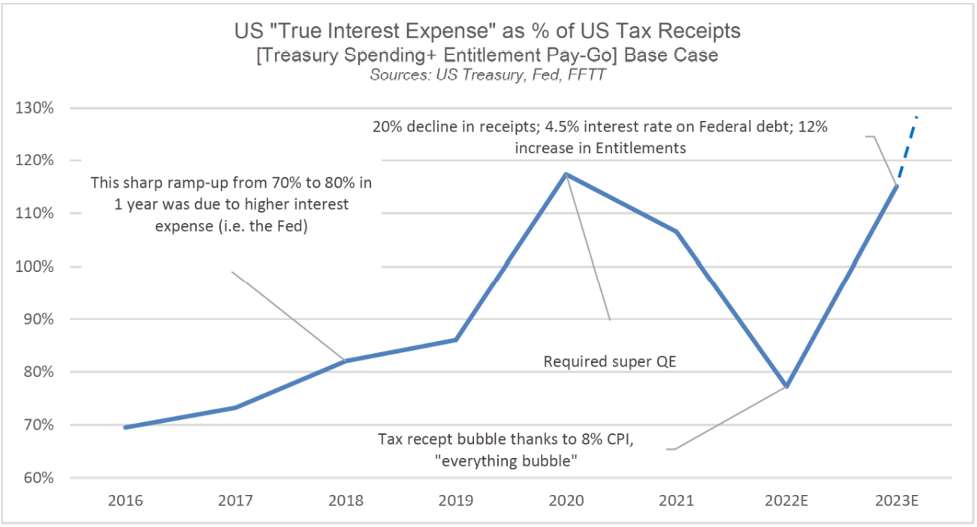
In other words, the United States (along with California…) are mathematically heading toward a bar-tab (i.e., interest expense bill) as painful as the one we saw in March of 2020, when markets tanked and the Fed was required to print trillions in less than 8 months just to keep Uncle Sam’s nose (and Treasury market) above water.
For now, however, the Fed is not printing trillions via QE, but tightening ala QT.
Or stated more simply, US debt obligations are sailing toward yet another debt iceberg, only now the issue is not about too few lifeboats, but no life boats at all.
As I see it, and have said many times prior, the US is trapped with no easy solutions as debt levels are rising and revenues falling.
The end result is obvious, even if the precise timing of the iceberg is not.
Whether Powell’s Fed continues to tighten into a debt iceberg, or eventually seeks to temporary melt (monetize) that iceberg with more QE, the nation is doomed either way in a Hobbesian choice between tanking markets (QT-driven) or skyrocketing inflation (QE-driven).
No One Likes Bears, and Even Fewer Understand Gold
Unless you are a talented short-trader or volatility option jock, no one likes bears or bear markets, and hence very few like to hear data-driven bears (mathematical realists) like myself constantly reminding us of the debt elephant in the room–and all that this toxic debt inevitably implies.
Once debt levels become fatal, the direction of credit, stock, property and finally currency markets are easy to diagnosis, though the time of death is not.
Gold, of course, loves dying currencies.
The price of gold today, or the strength or weakness of the USD tomorrow, are frankly silly questions in the short term for any who understand the broader context of the long-term.
Currencies are always the last bubble to pop, and given that gold is a store of value rather than an instrument of speculation, gold investors (i.e., those whose aim is wealth preservation not asset speculation) recognize that gold never rises, currencies just fall.
Investors in physical gold therefore measure their wealth in ounces, grams and kilos, not highly toxic, increasing debased and (forever debated) fiat currencies whose race to the bottom is literally happening right before our eyes in real time.
To dismiss such simple deductions from admittedly complex market forces as just “gold bug” thinking ignores math, history and gold cycles.
But again, no one likes to see bears, even when they’re staring at them from the Californian state Capital.

Based on all the debt destruction (and coming consequences) I see in California, the United States and the world in general, I suppose I’ll still just be a “bear” and a “bug” to most.
But both are better than a sitting duck.
Jerome Powell: Misunderstood Angel or Open Devil?
Below we examine the historical interplay of losing wars, cornered egos, tanking currencies, greater controls and gold’s loyalty in times of open madness.
History Matters
Despite the fact that universities even in the Land of Lincoln have had a say in cancelling Abraham Lincoln (good grief…) for apparently not being “woke” enough circa 1861 to be as wise as the neo-liberal faculties of 2023, I’d still make a case that history matters, and by this, I mean all its wonderful and ugly nuances (and lessons), whether they offend modern sensibilities or not.
History, of course, is full of desperate figures and times, many of which involve desperate economies followed by equally desperate (proxy) wars and desperate turning points.
In this light, the more things change, the more they stay the same. Just look around you…

And in the largely forgotten history of war, there is no shortage of desperate generals at desperate turning points.
Wars Doomed from the Start
Napoleon, who having previously won countless battles from Rivoli to Austerlitz, found himself shivering through an 1812 Russia after losing the vast bulk of his army to General Russian Winter and remarking to one of his generals that it’s “only a fine line between the sublime and the ridiculous.”
Three years later, at Waterloo, Napoleon’s “sublime” days (and countless casualty numbers) ended for good.

At Gettysburg, on the 3rd day of July, 1863, an equally talented and grossly outnumbered Confederate States Army under Robert E. Lee, having humbled Union forces at Manassas 1 & 2, Fredericksburg, Gaines Mill and Chancellorsville, looked across an open field from Seminary Ridge to the Emmitsburg Road strewn with the dying and dead of his once bravest divisions as the U.S. Civil War reached a mathematical turning point.

Despite this carnage, the war (post Pickett’s doomed July 3rd charge) dragged on for 2 more horrendous years (and countless casualty numbers), ignoring the hard math of waning troop numbers, supplies, cannons and horses which now rendered Southern “victory” impossible.
Less than a century later, this time near Stalingrad in the winter of 1943, the seemingly invincible German Wehrmacht, having conquered Poland, France, North Africa and large swaths of the East, found itself (and General von Paulus) facing the equally mathematical reality of what once seemed like impossible defeat.

By all metrics the Germans, having engaged in a two-front war, were done, but the war (and countless casualty numbers) would continue for two more senseless years.
But what do any of these examples of doomed and costly wars have to do with current global markets and our financial “generals”?
In fact, quite a bit.
Financial Policies Doomed from the Start
The overlapping interplay of human ego, hard math, and failed strategies doomed from the start have their place in both military and financial history.
For example, once upon a time (circa 2008), our central bankers in general, and the U.S. Fed in particular, had the insanely bad idea that central banks could use fiat money created out of thin air to save bad banks, defeat recessions, manage inflation, monetize debt, win a Nobel Prize and ensure total employment with a “Pickett’s charge” of mouse-click money.
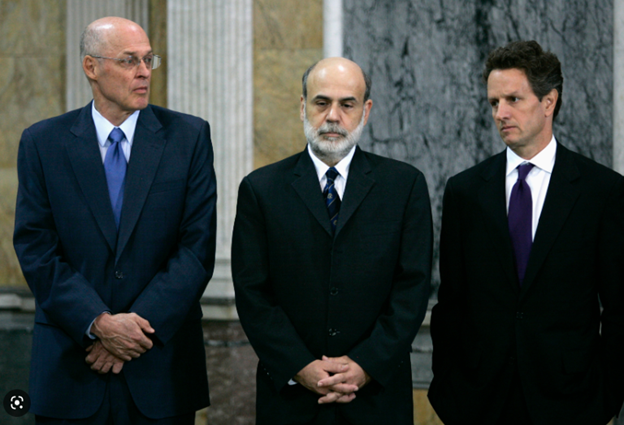
Such grand plans, like the promises of failed generals and insane wars of Lebensraum, la gloire de l’empire or the “Southern Cause,” were initially followed by a string of early “Austerlitz-like successes” (i.e., market bubbles) which brought near-term euphoria.
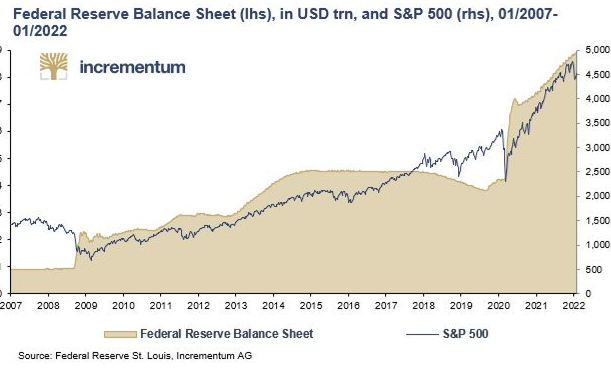
Unfortunately, those early and mouse-clicked victories ignored the longer-term realities/casualties, namely: historically unprecedented wealth inequality, grotesque currency debasement, the death of free-market price discovery and the birth of what amounts to little more than Wall Street socialism and market feudalism masquerading today as MMT “capitalism.”
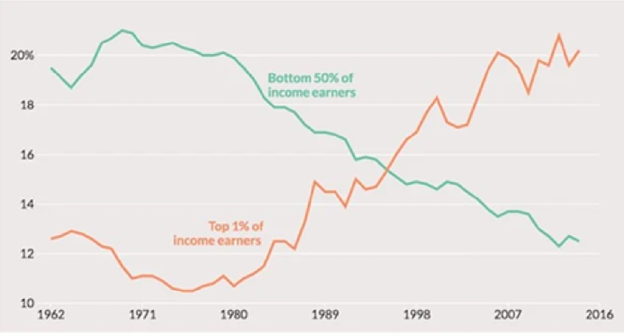
Such short-term “glory” at the expense of longer-term ruin is a pattern all too familiar for those paying attention…
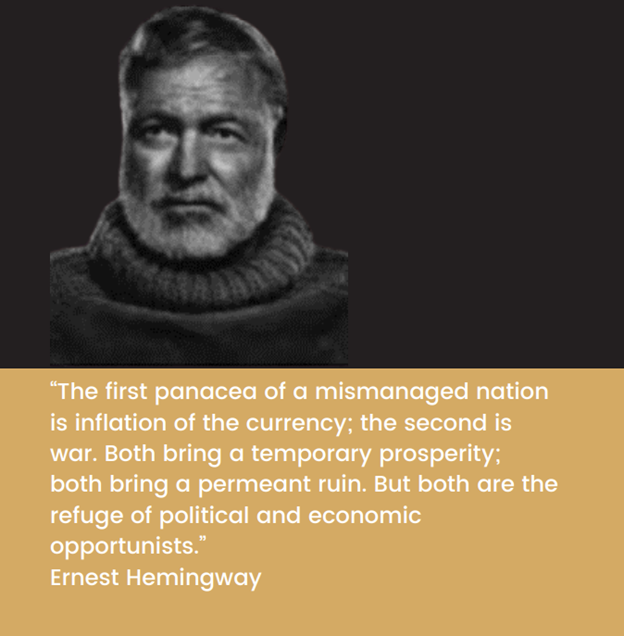
Emperor Powell, for example, thinks he can “win the war against inflation,” but like Napoleon, Lee and von Paulus, he is still unable to admit to himself (or us lieutenants) that his grand vision is doomed either way.
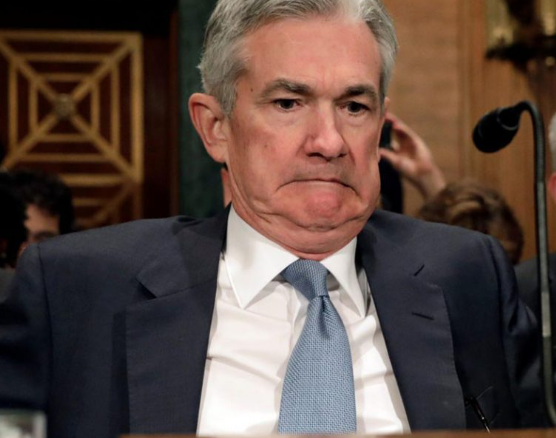
And so, he continues to desperately fight a losing cause at the expense of countless currencies and investors (casualties) around the world.
How can we know this?
It All Boils Down to Hard Math and Bad Options
As detailed in prior reports, the math speaks for itself.
Global debt levels are past their “Gettysburg moment”—there are no easy victories left once we start dealing in the quadrillions…
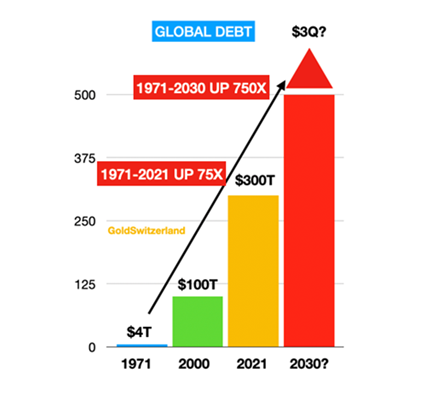
Whether Powell continues with QT or pivots to more QE, retail foot-soldiers here and abroad face either economic recession/depression or extreme inflation.
Pick your “victory” or your poison. I see both, namely: Stagflation
Equally serious is the inevitable demise of the USD’s purchasing power at home and the slowend of its hegemony in the world.
The Sad Fate of the USD
Regardless of whether the USD (DXY) rises or falls in the near-term, the end result is as inevitable and mathematical as Germany’s two-front war, Pickett’s charge or Napoleon’s Waterloo: Disaster.
Once stock and bond bubbles reach their tipping points, the last bubble to die is always the currency, which is precisely where our prize-winning (?) central bankers have placed us.
In short, and as shown below, the global economy and USD, led by Field Marshall Powell, is about to cross that infamously fine line from the sublime to the ridiculous…
The USD’s Sublime Last Moments
As in any losing war, however, there are always those clinging for hope, including those who think the USD will never, well…surrender. (In 2022, the British pound, the yen and the euro already caved…)
Recently, for example, the headlines, politicos, markets and perma-bulls were positively giddy over the stronger than expected US jobs report and non-farm payroll data. The DXY climbed in lock-step.
However, what was equally higher (60% higher…) than expected was the 2023 US Treasury borrowing estimate –aka: Uncle Sam’s increasing bar tab–$930B! –for Q1 alone.
Each of these data points has sent the USD temporarily higher, along with inflation expectations, which now seem to be embedded.
So, the big question today is this: Will the USD get stronger or weaker in 2023 and beyond?
There are two camps in this strategic debate, and two consequences depending on which camp is right. Neither are “victorious.”
Bad Scenario 1: A Rising Dollar’s Consequences
If the USD gets stronger, it kills just about every asset class but the USD…
Already, we are seeing this open carnage in credit markets as rising rates and General Powell’s strong-Dollar policies cripple lending and borrowing norms of the past.
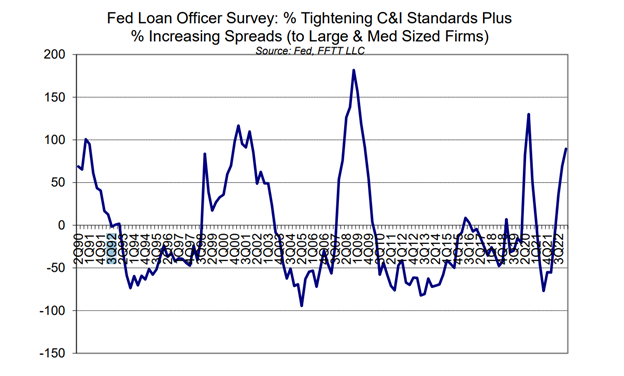
Loan officers are confirming a tightening of credit availability (and a widening of bank lending spreads, above) at levels only seen in prior recessions, adding more weight to my ongoing contention that the US is already in a recession, despite every Göbbels-like attempt in DC to redefine, cancel, ignore or downplay the same.
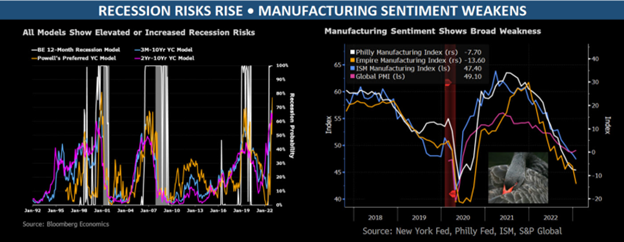
The equally dismal rise of defaulting High Yield bonds adds further proof of the slow (then steady) death of bleeding bonds in a rising rate and strong USD backdrop/policy.
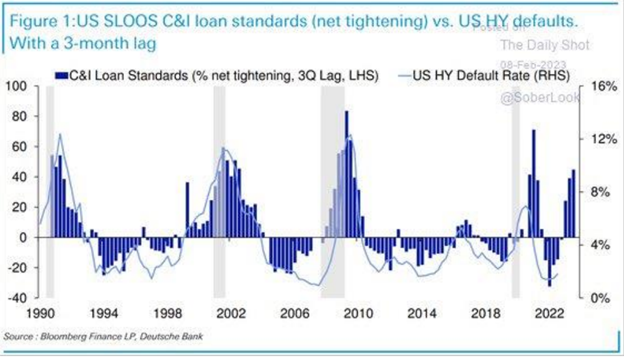
A strengthening USD will send bonds down and hence yields and rates higher, which will be deflationary as debt-soaked America gets poorer and foreigners are forced to sell more USTs alongside a tightening Fed which is doing exactly the same thing—namely: Bond dumping and yield-spiking.
Bad Scenario 2: A Falling Dollar’s Consequences
However, if the USD gets weaker, the inflation we are already feeling will only get worse as $2T+ deficits make their steady climb North toward $3T, $4T or even $5T+ for 2023.
So, once again: Will the USD get stronger or weaker?
The answer lies in what signals (or desperate generals) you track or trust: Powell’s Fed or the UST market?
Trust What Powell SAYS?—Strong Dollar Ahead
If, for example, you follow the Fed and its bogus yet deadly-serious inflation narrative, then you will be lured into Powell’s “we must beat inflation” war cry, which boils down to a zero-sum battle-plan of “high inflation bad, low inflation good. Must beat inflation.”
Equally part of this bogus battle plan (Powell needs inflation and negative rates…) is the courageous meme that “rising rates kills inflation.”
Well… yes, but at what cost?
If Powell wins the headline battle against inflation, he loses the war for global credit markets, economies and political credibility, which loss will be immediately blamed on a virus and Russian bad guy but never on the mad generals who pushed us over the debt cliff.
However, if we get beyond linear headlines and two-dimensional thinking of central bankers like Powell, we quickly realize that the 3-dimensional UST market is perhaps the real (and superior) indicator of future probabilities.
Or, Trust What Bond Markets DO?—Weaker Dollar Ahead
Thus, rather than watch the Fed, I’m looking at bond markets to get my directional compass-North in a world of policy cannon smoke.
As said more times than I can count: The bond market is the thing.
And as for the sovereign bond market, it has seen 3 periods of complete dysfunction in recent years, namely: 1) the repo rate spike of September 2019; 2) the March 2020 “Covid” crash, and 3) last October’s gilt implosion spawned by the rising USD.
Those who follow the Fed (and this is entirely understandable given that the Fed IS the market in our post-2008 centralized nightmare) can’t be blamed for therefore expecting the USD to rise on more tightening and Powell “inflation-fighting.”
But those who follow the Fed are also ignoring those 3 bond market cracks in the ice above.
It’s my view that this ice is about to break if we have a 4th “uh-oh” moment/crack in sovereign bonds.
Thus, rather than follow the Fed, we might be wiser to look at the UST market, which is heading precisely in that “uh-oh” direction unless someone (i.e., Yellen?) pushes another meme—namely more toxic liquidity and thus a weaker USD.
But as previously argued, either way we are doomed…
Failed Battle Plan 1: Tightening into a Debt Crisis (Stronger Dollar)
Let’s play out the Fed’s current scenario first.
If we look only at what the Fed says, and it tightens, which, for now seems like the plan for Q1 and Q2, the USD will strengthen, yields and rates (5% to 5.25%) will rise further and the UST market will see such a wave a selling (foreign and QT Fed-driven), that a fourth “uh-oh” moment in the sovereign bond market will be inevitable, and likely enough to not only “crack the ice” of global bond markets, but drown everyone skating above it.
Given these realities and risks in the UST market, risks which even a fork-tongued and totally cornered Jerome Powell understands, I see no realistic way forward other than a weaker USD and thus a move from QT to QE.
Why?
Again: Because I’m taking my signals from the bond market not Powell.
To track (and trust) Powell means a tanking US Treasury and fatally rising rates, which is like kryptonite to America’s debt-based “accommodation” model.
Instead, I believe Powell will be forced to strategically consider the fact that this inflation war has killed his army of USTs and hence force him (at Yellen’s direction) to change tactics.
Or stated more simply, just as Napoleon, Robert E. Lee, and even the Wehrmacht learned that no outnumbered army can win an extended war, Powell will discover that no sustained policy of rising rates can end well for the toxic bonds/IOUs which float a bankrupt nation.
In short: Unless Powell weakens the USD and injects more QE liquidity sometime in 2023, his victory over inflation will be at the expense of America’s life-blood—namely the UST market.
Failed Battle Plan 2: Resort to More Mouse-Click “Miracles” (Weaker Dollar)
At the end of the day, and despite all this “beat inflation” rhetoric from Powell, it is my admittedly contrarian and unpopular (don’t say “gold-bug”) view that saving Uncle Sam’s IOU lifeline (i.e., the UST market) will take strategic priority over “beating inflation.”
By the way, this appears to be a view shared by none of other than that Corps Commander of toxic liquidity herself: General Janet Yellen…
In other words, expect an eventual (not immediate) capitulation to more fake money—aka, QE, i.e., “liquidity.”
This means that despite gyrating USD moves and hence DXY flip-flops today, the only direction and choice in the longer term to beat a recession and save Uncle Sam’s IOUs is a weaker not stronger Dollar.
Ultimate End-Game? Blame, Reset and Centralized Control
A weaker USD will buy time (and USTs) until ultimately the developed economies of the world, which in fact have the balance sheets of banana republics, finally realize that there’s still nothing left to save them but a great big “reset”—i.e., a global Chapter 11 or Economic “Versailles Treaty.”
The need for this “re-set” will, of course, be conveniently blamed on Putin and Covid rather than the central bankers (failed generals) who caused this horrific war on real money, sustainable debt and sound fiscal spending years ago.
At that point, history will remind us that lost wars and failed policies always devolve into more centralized controls masquerading as governmental “guidance,” payment efficiency and “democratic” leadership, nicely encapsulated in that toxic new direction of Central Bank Digital Currencies and a more Orwellian new normal…
But I digress…
How to Position Yourself?
Switching from military to equestrian metaphors, I argued in 2022 that investors, like polo players, need to think where the ball is headed, not where it lies currently.
Regardless of what Powell says today, the real play is 3 to 4 moves ahead, which all point toward an inevitably weaker USD and thus an inevitably rising gold price.
Powell, of course, is more politician than economist, and central banks like the Fed are anything but independent.
As such, Powell, DC and the creative math and fiction writers at the BLS will continue to do what all politicians (or losing armies) do when things are going against them: Lie.
Thus, the DC creative writers will continue to fudge, distort and “tweak” the CPI data to mis-report true inflation as nearly “beating expectations,” thereby allowing Powell to save face in a losing “war against inflation” while Lieutenant Yellen quietly pushes a weaker USD narrative to save the UST market (i.e., prevent more foreign UST dumping).
This face-saving policy will then allow the US to do what it does best: Borrow, spend and go deeper into inflationary debt spirals.
The Pesky Human Factor
Based on bond market Realpolitik, the probabilities point toward a liquidity pivot and weaker USD, longer term.
But history also reminds us that power-drunk figures don’t like to admit defeat. Their egos get in the way of rational decisions.
Powell, who desperately wishes to be remembered as a Napoleonic Paul Volcker rather than a comical Arthur Burns, is no exception to such human-all-too-human small-mindedness.
Unwilling to accept a Gettysburg moment that originated with Colonel Greenspan, General J. Powell could indeed push too far and too long with rising rates, a stronger USD and tanking bonds until inflation and everything else is destroyed.
We can only wait and see.
The Gold Factor
Whether on battlefields or economic cycles, man’s history of the absurd and his disloyalty to the many for the benefit of a few is nothing new under the sun.
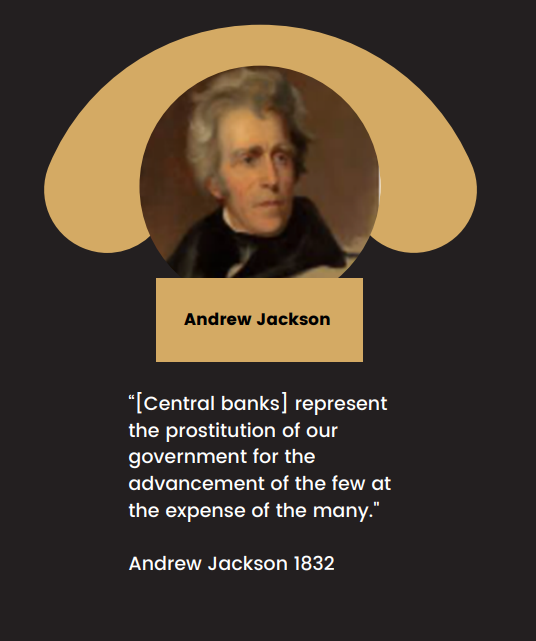
In short, chaos eventually rears its head.
Powell or Yellen, QT or QE, inflation to deflation, left or right, Davos or DC, the chaotic results are always the same: Currencies and markets die, opportunists, lies and controls increase and the little guy (and common sense) gets trampled, drafted or “cancelled.”
Physical gold, of course, loves chaos and offers far greater loyalty to those who put their trust in this natural metal rather than flimsy paper money and the even flimsier promises from on high.
So which form of money will you trust to preserve your wealth?
A digital and speculative “coin” promoted by human cons that is anything but stable?
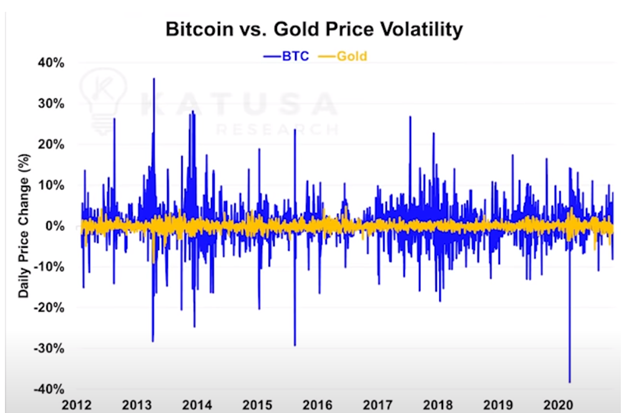
A fiat currency that is losing its purchasing power by the second?
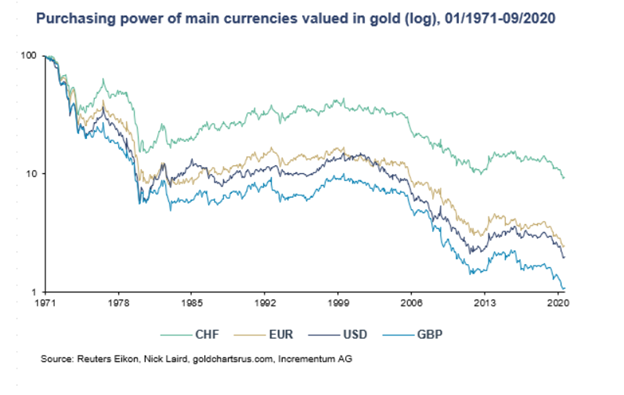
Or a naturally finite monetary metal with infinite duration born from the earth rather than an anonymous code writer or over-heating printer?
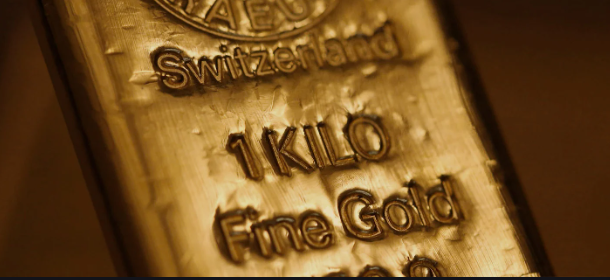
The choice, of course, is yours.
